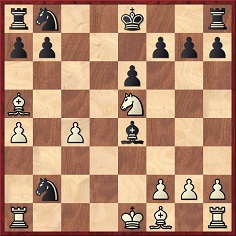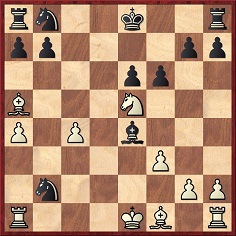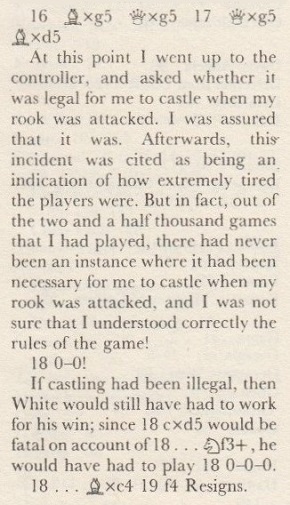Chess Notes
Edward Winter
When contacting us by e-mail, correspondents are asked to include their name and full postal address and, when providing information, to quote exact book and magazine sources. The word ‘chess’ needs to appear in the subject-line or in the message itself.
| First column | << previous | Archives [135] | next >> | Current column |
9510. St Louis, 2015
As mentioned in C.N. 9368, we show recent signed items from our collection only occasionally. The latest addition, a photograph taken during the first round of the Sinquefield Cup in St Louis on 23 August 2015 and signed by all ten participants, has kindly been sent to us by Yasser Seirawan:

9511. ‘According to Wikipedia ...’
To state the obvious, or what ought to be, great wariness is required over ‘community’ websites which, instead of trying to get matters correct from the outset, allow individuals, usually unnamed, to post whatever they choose. The onus is placed on others to try to make rectifications if they can be bothered.
In the particular case of Wikipedia, the quality of chess entries varies enormously (C.N. 5919 named two good ones, and there has been considerable overall improvement to the site since then). Discernment remains essential, and quoting Wikipedia is not a step to be taken lightly.
In C.N. 8110 (see Chess: The Need for Sources) a correspondent pointed out that in The Immortal Game by David Shenk (New York, 2006) ‘details of Spassky’s chess career are attributed to a Wikipedia entry’. Recent books with no qualms about citing Wikipedia include Miguel A. Sánchez’s volume on Capablanca (C.N. 9456); see pages 509 and 527. From the latter page:
‘According to Wikipedia ... But according to the more reliable version of Andy Soltis in ...’
McFarland books really should do better than that.
In Players and Pawns (C.N. 9500) the endnotes offered by Professor Gary Alan Fine include one on page 241 which gives a Wikipedia link combined with a reference to an atrocious book by Larry Evans, This Crazy World of Chess. On page 256 the Professor refers to Wikipedia for information about Claude Bloodgood.
On page 9 of Carlsen move by move (London, 2014) the vastly over-published Cyrus Lakdawala even quoted Wikipedia on matters of opinion:
‘Wikipedia says of Carlsen’s opening play: “He does not focus on opening preparation as much as other top players, and plays a variety of openings, making it harder for opponents to prepare against him.”’
The most glaring example found so far of a chess book’s lazy use of Wikipedia is on page 11 of Chess Openings for Dummies by James Eade (Hoboken, 2010):
‘According to Wikipedia, The Oxford Companion to Chess lists 1,327 named chess openings and variations.’
9512. Jottings on a wonderful study (C.N. 9508)
Joose Norri (Helsinki) notes an article by T.G. Whitworth about the 1922 study on pages 69-70 of EG issue 69 (July 1982): ‘Kubbel – A Case of Lèse Majesté?’.
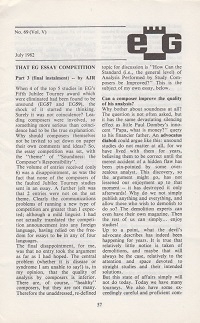
9513. Speyer/Speijer v Lasker match
From Jan Kalendovský (Brno, Czech Republic) comes the front page of the Dutch publication De Revue der Sporten, 7 January 1909:
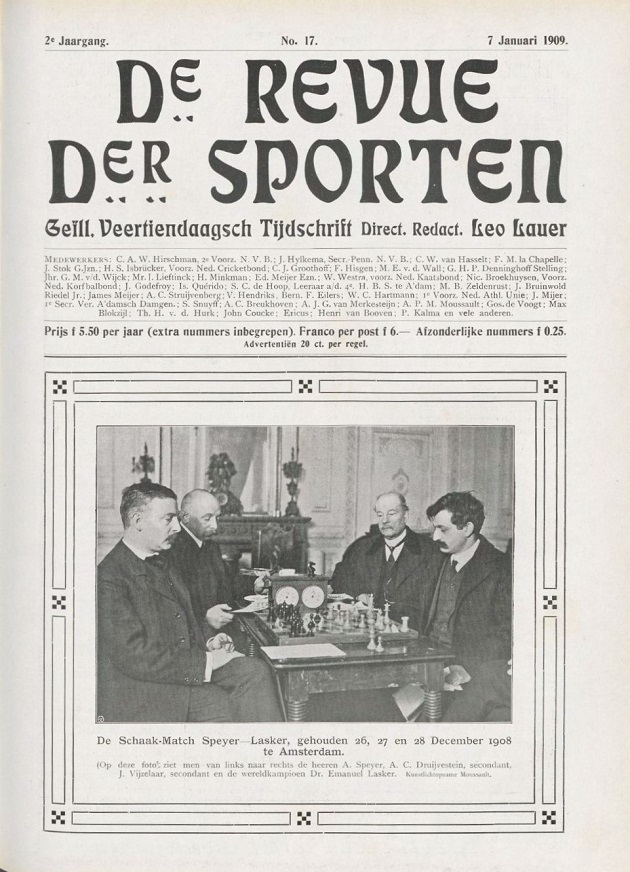
The position is recognizable as from the second match-game, a draw played on 27 December 1908.
9514. Rotlewi, Alekhine and Euwe
Jan Kalendovský has also sent the items below:

De Revue der Sporten, 8 November 1911, page 410
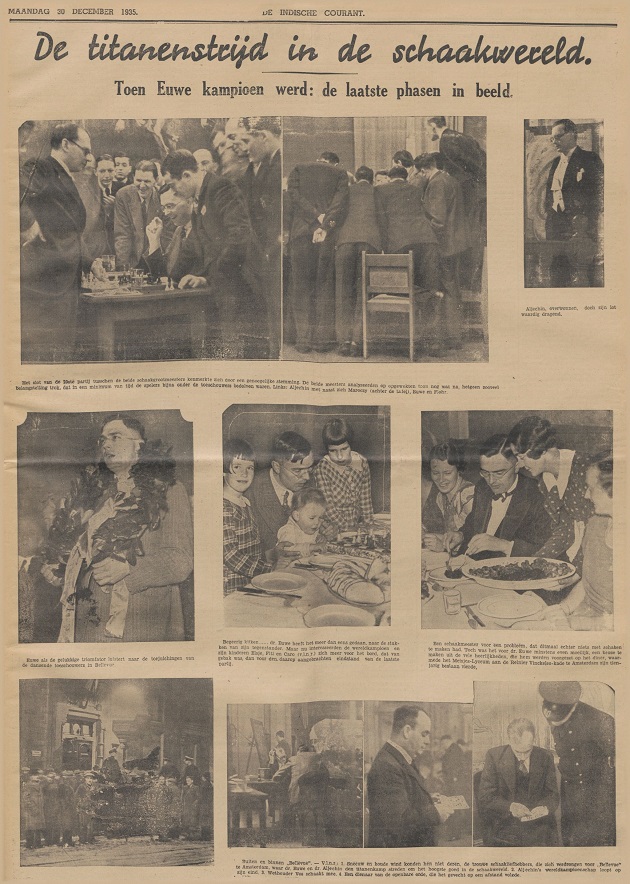
De Indische Courant, 30 December 1935, page 13

De Telegraaf, 7 October 1937, page 4
9515. Capablanca v Spielmann, New York, 1927
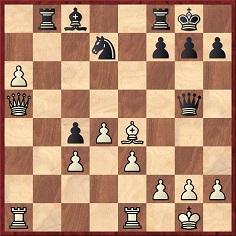
Position after 20 bxa6
‘The combination here is unique in the literature of chess games. Where else can one find a rook’s pawn on the sixth rank stronger than a queen?’
Source: page 24 of Solitaire Chess by I.A. Horowitz (New York, 1962). Horowitz had not included that curious remark when his article, ‘Spielmann Outspielmanned’, was published on page 9 of Chess Review, January 1955.
The full game-score, for ease of reference: 1 d4 d5 2 Nf3 e6 3 c4 Nd7 4 Nc3 Ngf6 5 Bg5 Bb4 6 cxd5 exd5 7 Qa4 Bxc3+ 8 bxc3 O-O 9 e3 c5 10 Bd3 c4 11 Bc2 Qe7 12 O-O a6 13 Rfe1 Qe6 14 Nd2 b5 15 Qa5 Ne4 16 Nxe4 dxe4 17 a4 Qd5 18 axb5 Qxg5 19 Bxe4 Rb8 20 bxa6 Rb5 21 Qc7 Nb6 22 a7 Bh3 23 Reb1 Rxb1+ 24 Rxb1 f5 25 Bf3 f4 26 exf4 Resigns.
As shown on pages 167-168 of our book on Capablanca, the Cuban annotated the game in an article on pages 1 and 2 of the New York Times, 13 March 1927. Among his comments: ‘We have been warmly congratulated by amateurs and experts alike for the manner in which we conducted the attack.’ He also provided notes on pages 245-248 of A Primer of Chess (London, 1935).
In the 1920s, other annotators included Maróczy (Kagans Neueste Schachnachrichten, April-June 1927, pages 304-305) and Alekhine in Das New Yorker Schachturnier 1927. (The English translation of the notes on pages 116-117 of the ‘21st Century Edition!’ (Milford, 2011) made no attempt to capture Alekhine’s prose style.) Réti gave the game in Masters of the Chess Board.
On page 143 of The Immortal Games of Capablanca (New York, 1942) Fred Reinfeld presented Capablanca v Spielmann as follows:
‘This might well be considered the classic Capablanca game. It shows his proverbial clean-cut and logical simplicity in its most attractive form.’
It was also the game that Harry Golombek picked for the section on Capablanca on pages 222-224 of The Game of Chess (various editions). The introduction stated:
‘Here is a game that seems perfectly natural once one has played through it; but no-one, save Capablanca, could have produced it.’
A detailed set of annotations, by John Nunn, was published on pages 149-152 of an anthology which he co-wrote with Graham Burgess and John Emms: The Mammoth Book of The World’s Greatest Chess Games (London, 1998). From the introduction:
‘Capablanca had the unusual ability to dispose of very strong opponents without any great effort. At first glance, there is little special about this game; the decisive combination, while attractive, is not really very deep. The simplicity is deceptive; a closer look shows that the combination resulted from very accurate play in the early middlegame.’
This photograph of Spielmann and Capablanca in the New York, 1927 tournament is in our monograph on the Cuban:
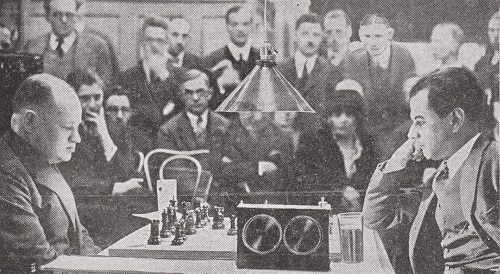
9516. A suggestion for David Smerdon
From ‘60 Seconds with ... Grandmaster David Smerdon’ on page 7 of CHESS, October 2015:

Leaving aside the confusion over Rowson’s Chess for Zebras and Webb’s Chess for Tigers, we suggest that, regarding his third choice, David Smerdon should read Copying.
9517. Photographic archives (11)
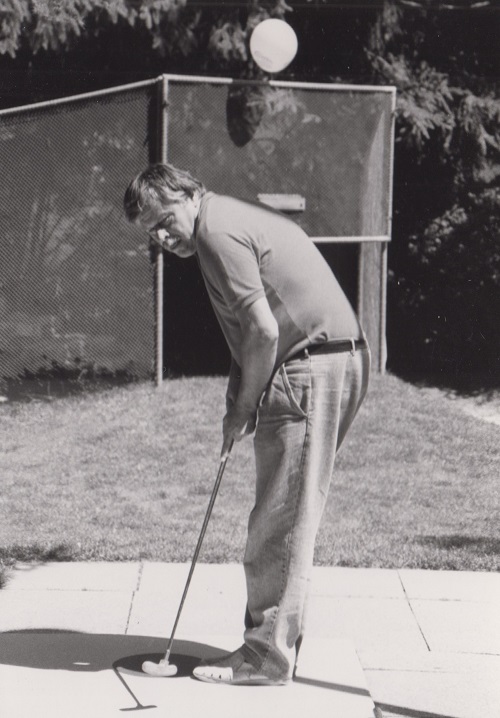
Vlastimil Hort

Anatoly Karpov
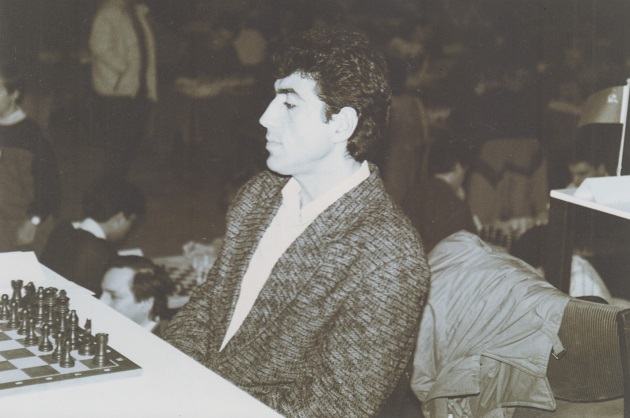
Smbat Lputian
9518. Petrosian (C.N. 9470)
C.N. 9470 discussed how Petrosian wrote his name in the Roman alphabet. David DeLucia (Darien, CT, USA) now reports that he has a copy of Tigran Petrosian His Life and Games by Vik L. Vasiliev (London and New York, 1974) in which Petrosian signed the first photograph in the plate section:
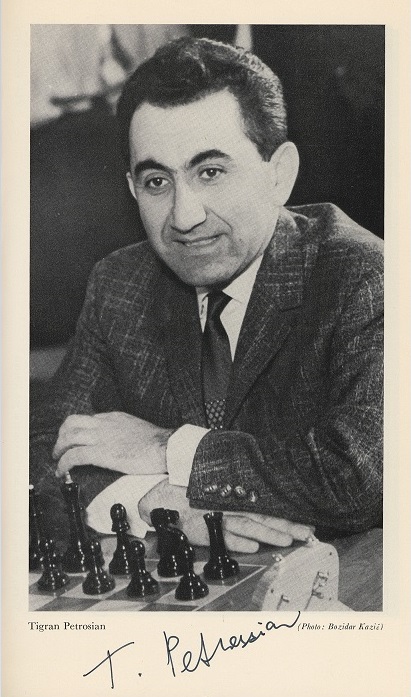
9519. Le secret de Morphy by Edgard Tchélébi
As shown in Zukertort v Blackburne, London, 1883, page 238 of the August 1963 BCM briefly noted that Edgard Tchélébi had died (aged 34, in fact):

The book referred to, Le secret de Morphy (Limoges, 1960), is scarce, and most writers on the great American master have ignored it, the preference nowadays being for material easily accessible online.
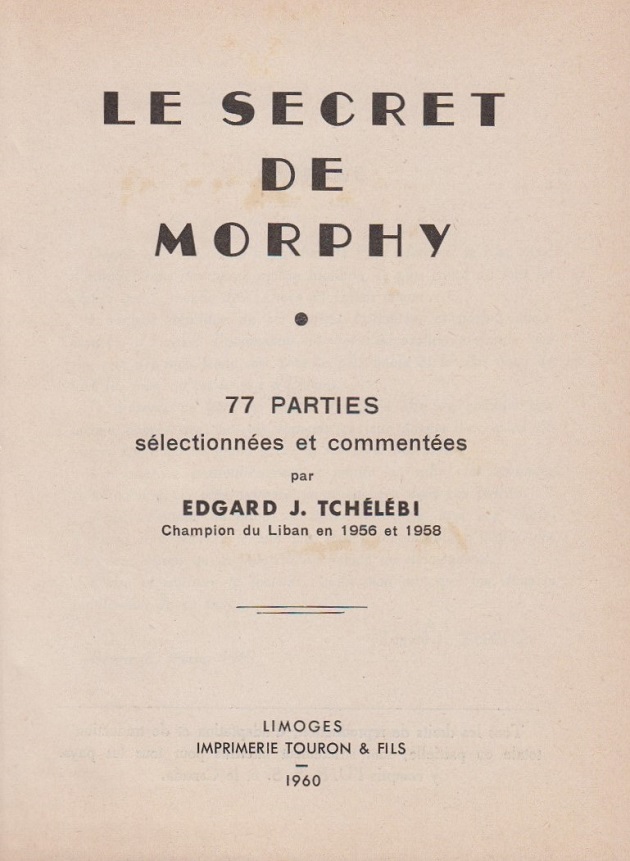

There was nothing austere about the 284-page hardback, and in the introductory matter Tchélébi’s multiple exclamation marks and SUDDEN CAPITALS were an unbecoming way of conveying his unreserved admiration. From page 8:

The Morphy v Anderssen game referred to was on pages 231-235:
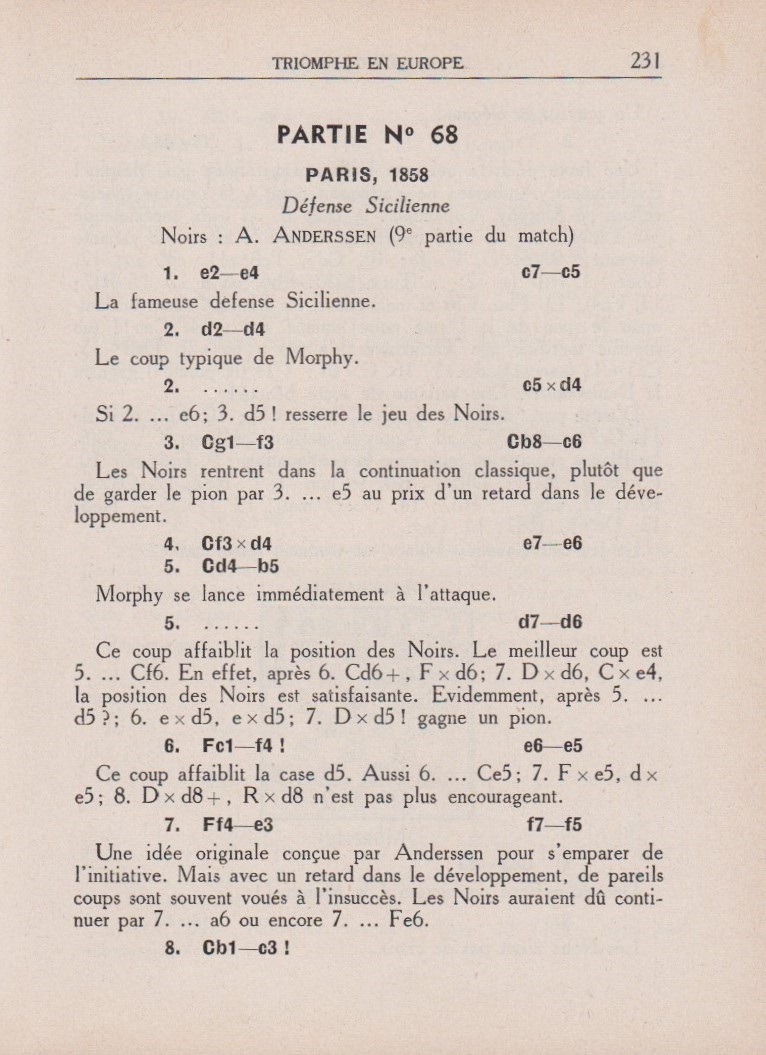
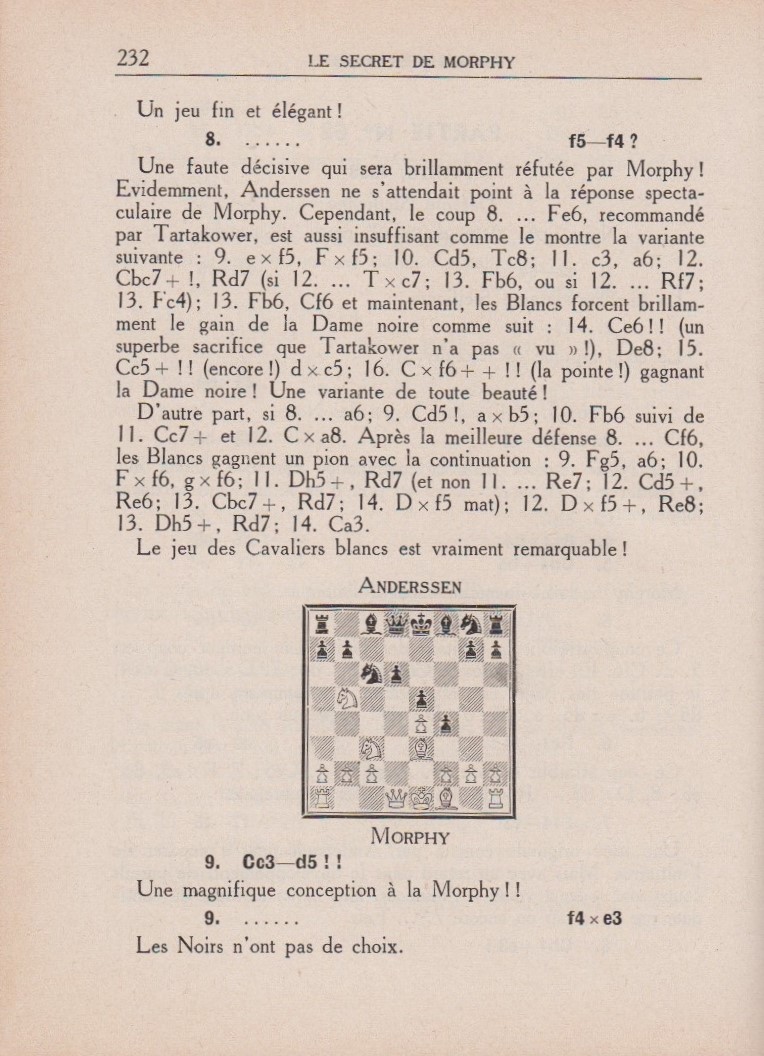
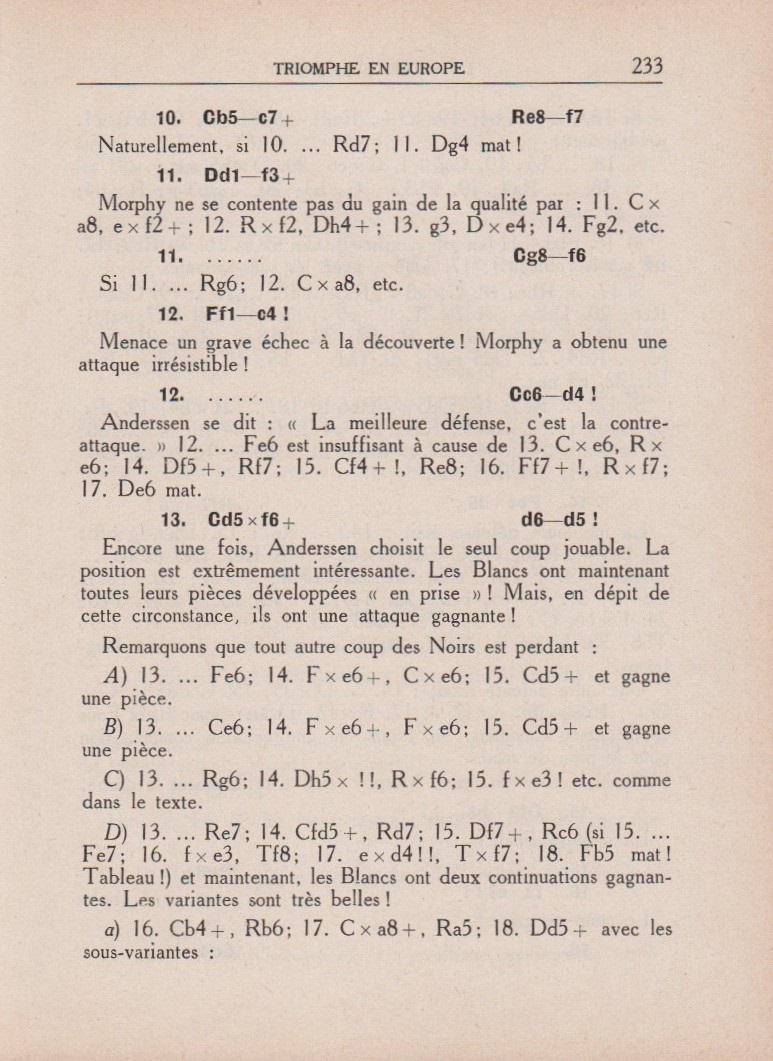

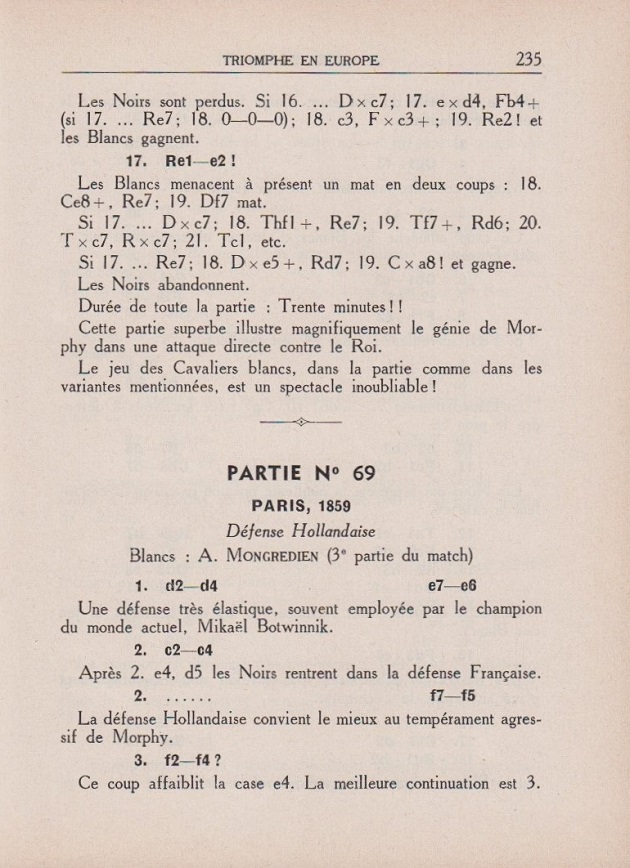
That encounter between Morphy and Anderssen (1 e4 c5 2 d4 cxd4 3 Nf3 Nc6 4 Nxd4 e6 5 Nb5 d6 6 Bf4 e5 7 Be3 f5 8 N1c3 f4 9 Nd5 fxe3 10 Nbc7+ Kf7 11 Qf3+ Nf6 12 Bc4 Nd4 13 Nxf6+ d5 14 Bxd5+ Kg6 15 Qh5+ Kxf6 16 fxe3 Nxc2+ 17 Ke2 Resigns) was one of only two match-games by the American which Steinitz believed could be called brilliant. On page 7 of the January 1885 International Chess Magazine he wrote:
‘On sifting the matter by a sort of statistical research, we were rather amused to find, and probably our readers will be astonished to learn, that out of all of Morphy’s match games with Paulsen, Löwenthal, Harrwitz and Anderssen, nay, even including his matches with “Alter” and Mongrédien, therefore in 56 games altogether, there were only two that can lay claim to being called brilliant, namely the ninth with Anderssen and the fourth with Harrwitz. As regards the former, Morphy leaves a bishop to be taken on the ninth move, for which he might gain a clear rook, coming out with the exchange ahead. He prefers instituting an apparently vehement attack, which might have resulted in an exchange of queens, Morphy remaining only with one pawn ahead, and with two knights against the adverse two bishops, and we do not agree that the game was so absolutely lost for Anderssen as represented by Löwenthal. Winning the exchange was more sure. Doubt has also been thrown by the Chess Monthly on the soundness of the sacrifice, on the ground that on the 14th move Anderssen might have played K-K2, a move which it would have been heresy to think of at that time, because it blocks up queen and bishop, but nowadays any second-class player would give it his first consideration if he has the chance of remaining a piece ahead; knowing that it has been often enough successful even with a pawn behind. However, Anderssen plays K-Kt3, overlooking a very brilliant winding up, of which his ingenious opponent fully avails himself.’
Morphy’s ‘secret’ was explained by Tchélébi on page 11:
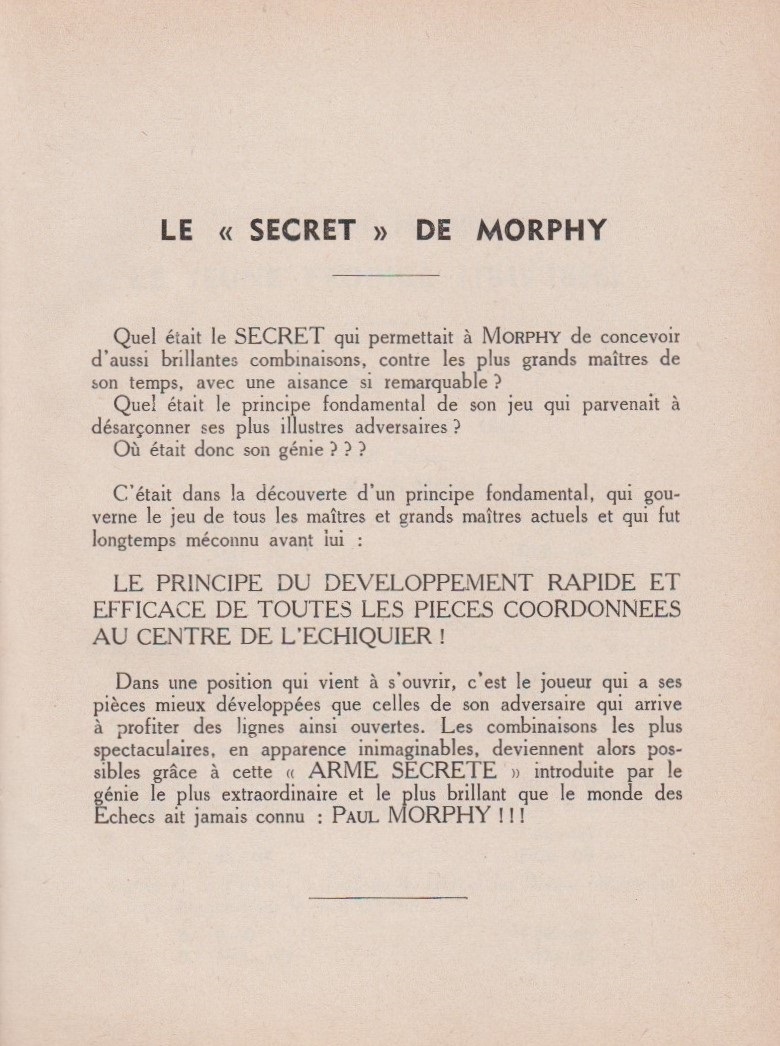
David Hooper sprinkled some vinegar on Tchélébi’s book, and on Morphy, in a short review on page 148 of the May 1963 BCM:
‘Although Steinitz and Lasker, and doubtless others, were in their time as much ahead of their contemporaries as was Morphy, and although they played a greater number of brilliant games and made deeper combinations, many players still regard Morphy as by far the greatest of them all, and his games are published again and again ...
No new light is thrown on Morphy by this book. It contains 11 of the serious games and 66 other games, all chosen for their combinative brilliance. The best of Morphy’s chess is here. The copious if effusive notes are easy to understand ...’
Before concluding ‘it may also be pointed out that Morphy sometimes made unsound sacrifices’, Hooper commented:
‘Before yet another book is written in praise of Morphy it may be pointed out that although he had studied the openings deeply he added nothing significantly new. The much praised 9 Kt-QB3 in the Evans’ Normal Position, and the defence 5...Kt-R3 in the Scotch Gambit after 4 B-QB4 B-B4 5 Kt-Kt5, are both in Staunton’s handbook; as for the Morphy Defence to the Ruy López, 3...P-QR3, he was shown it by Löwenthal.’
9520. Tsar Nicholas II
Information about Tsar Nicholas II and the ‘Grandmaster’ title has yet to be found in Russian sources at the time of the St Petersburg, 1914 tournament, but Dan Scoones (Coquitlam, BC, Canada) notes a Soviet perspective by Lev Travin on pages 4-5 of the 14/1974 issue of 64:
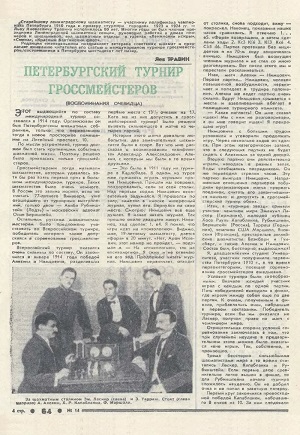
Our correspondent has translated the relevant section, at the start of the article:
‘This international tournament was held in 1914 and featured an outstanding entry. It was organized by the St Petersburg chess circle, which had just moved into a spacious new building at 10 Liteyny Prospekt.
The organizers’ intention was to make it the largest chess event of the day, and it was therefore decided to invite only grandmasters.
At that time, the term “grandmaster” was reserved for players who had gained at least one first prize in a major international tournament. There were very few such players. With the exception of the 77-year-old Winawer, who had retired from tournament chess, there were only two players in Russia who held the title: Akiba Rubinstein of Łódź, and the Moscow lawyer Ossip Bernstein.
The other Russian masters were invited to participate in an event known as the All-Russian tournament, the winner of which would be admitted to the grandmaster tournament ...’
9521. Problem by Dawid Przepiórka
The photograph taken in The Hague in 1928 serves as a reminder of a problem published on page 79 of David Przepiórka A Master of Strategy by H. Weenink (Amsterdam, 1932):
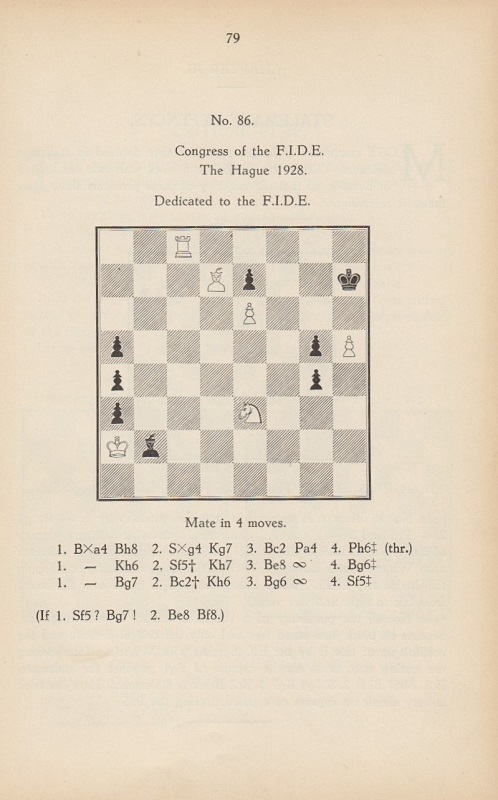
9522. Prague, 1931 (C.N. 6154)
A fine copy of the photograph in C.N. 6154 was published opposite page 72 of Comparative Chess by Frank J. Marshall (Philadelphia, 1932):
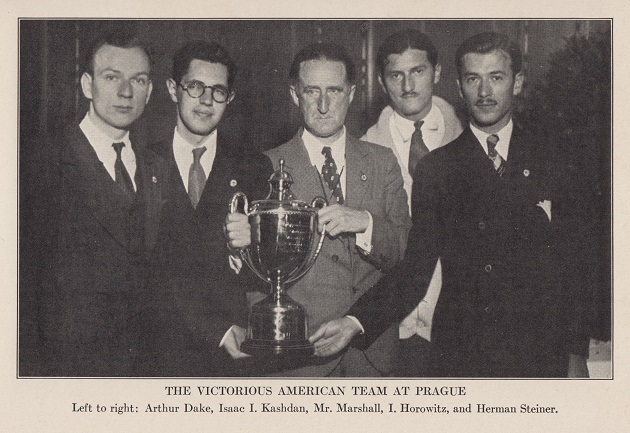
9523. Comparative Chess
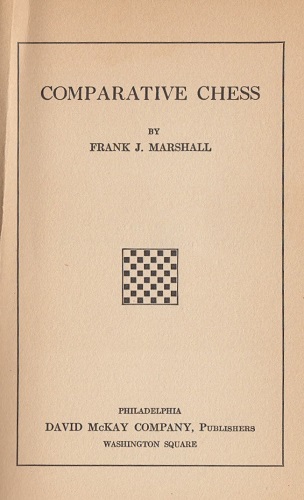
On page 27 of Comparative Chess Marshall gave some singularly unhelpful notes to the start of the game between ‘Makaarzyk’ (Makarczyk) and Steiner, Prague International Team Tournament, 1931:
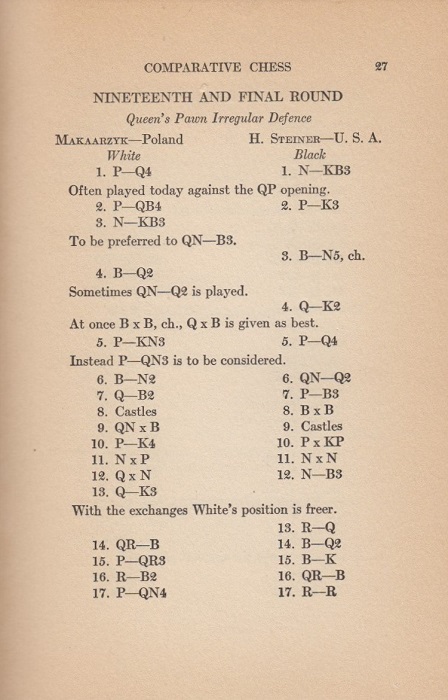
9524. Photograph collections
Regarding Chess History: Photograph Collections, an addition is the Dutch Nationaal Archief.
9525. Blackburne v Mackenzie (C.N. 5935)
In C.N. 5935 a correspondent enquired about a ‘Blackburne-Mackenzie’ game which he had seen only on page 456 of Carlo Salvioli’s Il Giuoco degli Scacchi (third edition, Livorno, 1921):
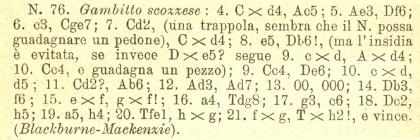
Our item asked what was known about the game, noting that it was still being given in much later editions of Salvioli’s book, e.g. on page 546 of the eighth edition (Florence, 1961).
Vitaliy Yurchenko (Uhta, Komi, Russian Federation) remarks that the game is on page 338 of T. Harding’s new book about Blackburne: Blackburne v Arthur John Mackenzie, simultaneous exhibition, Birmingham, 18 October 1894, as published in the Birmingham Weekly Mercury, 20 October 1894.
We note Harding’s comment that it was included in the book ‘chiefly to clear up a confusion because the win has sometimes been attributed to G.H. Mackenzie’. The corresponding endnote (page 552) provides no information as to where any such attribution has been made, but refers only to our C.N. item, posted ‘on 34 [sic] January 2009’. That material (C.N. 5935) did not mention G.H. Mackenzie.
9526. Bird and Buckle
C.N. 9457 observed regarding Joseph Henry Blackburne. A Chess Biography that ‘the work as a whole would have benefited from greater attention to certain C.N. material’. Page 111 of the book provides another example:
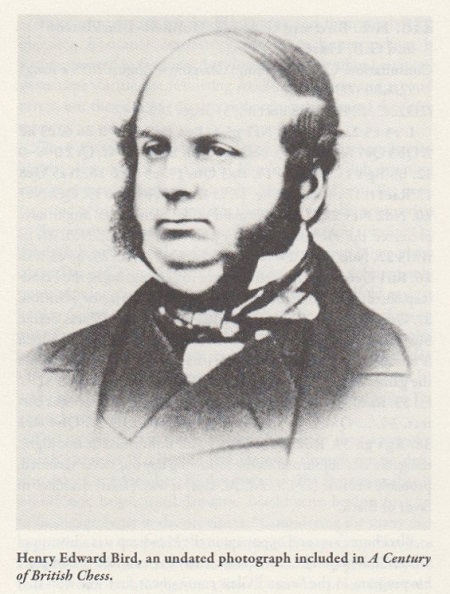
The picture shows not Henry Edward Bird but Henry Thomas Buckle, as was pointed out in C.N. 8346 in connection with page 29 of the hardback edition (1977) of Harry Golombek’s Encyclopedia of Chess:
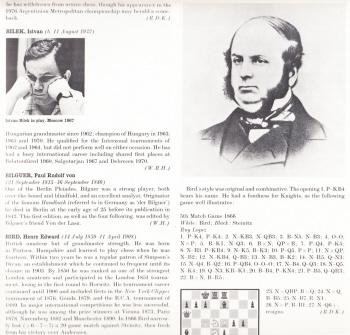
The Harding book (as well as Emanuel Lasker Denker Weltenbürger Schachweltmeister – see page 691) took the illustration from opposite page 194 of A Century of British Chess by P.W. Sergeant (London, 1934):


We do not know why Sergeant/Diggle thought that the
picture was of Bird.
It was included in an item about Buckle (C.N. 3464), and below are the frontispiece and title page of Essays by Henry Thomas Buckle (New York, 1863):
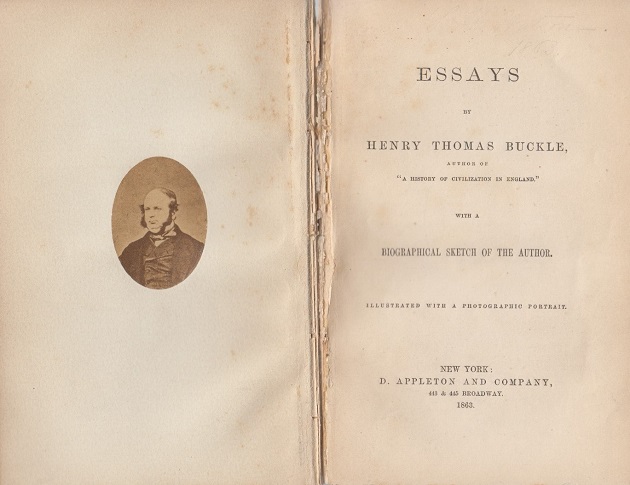
9527. Bird, Gunsberg and Blackburne
Olimpiu G. Urcan (Singapore) has sent us two photographs, taken in early 1894, of H.E. Bird, I. Gunsberg and J.H. Blackburne:
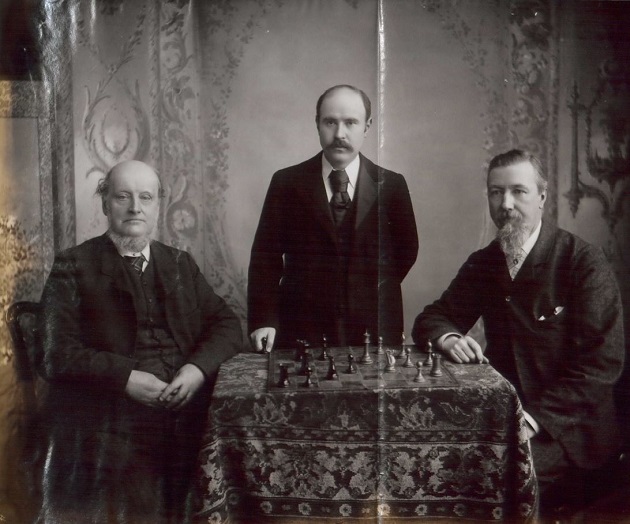
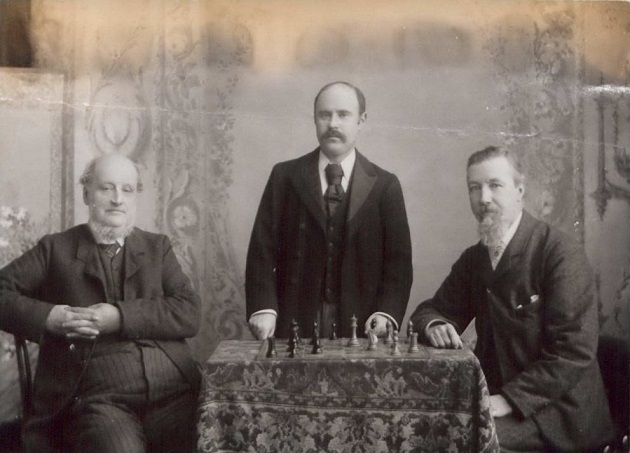
Our correspondent’s source is as specified in C.N. 9296, where forgotten portraits of Lasker and Blackburne were presented. The first shot of Bird, Gunsberg and Blackburne above was included, from a different source, on page 132 of Tim Harding’s fine book Eminent Victorian Chess Players (Jefferson, 2012).
9528. Marshall v Lasker, Paris, 1900
Thomas Niessen (Aachen, Germany) writes:
‘There are discrepancies in the score of the game between Frank Marshall and Emanuel Lasker in the Paris tournament, 28 May 1900, and particularly at moves 17 and 28.
Position after 16...Be4
When the game was published on page 9 of the Times, 6 June 1900, the continuation was 17 Bc3 f6 18 f3.
Those same moves were in the 10 June 1900 editions of the New York Times (page 10) and the Brooklyn Daily Eagle (page 9), as well as two Prague newspapers, Bohemia (page 17) and Národní listy (page 13). Other British and American newspaper followed suit.
However, when Leopold Hoffer published the game in the Field on 9 June 1900 White’s 17th and 18th moves were inverted, becoming 17 f3 f6 18 Bc3.
Position after 17 f3 f6
No note was added, but, when it gave that version of the score, page 8 the Pall Mall Gazette, 12 June 1900 stated, “The simplest is always the best” and mentioned that 18 fxe4 fxe5 19 Bc3 could be played.
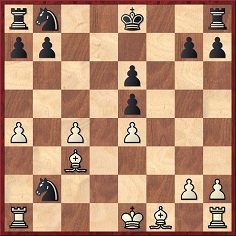
Position after 19 Bc3
The question, therefore, is whether White played 17 Bc3 (17...f6 18 f3) or 17 f3 (17...f6 18 Bc3). In the descriptive notation the difference is slight (B-B3 and P-B3), but the move-order 17 f3 f6 18 Bc3 would mean that a major oversight was committed by both Lasker (when he played 17...f6) and Marshall.
The 17 Bc3 f6 18 f3 version appeared in the Tijdschrift van den Nederlandschen Schaakbond, June 1900, pages 134-135, and the Deutsche Schachzeitung, July 1900, pages 208-209, as well as in Samuel Rosenthal’s Traité des échecs et Recueil des Parties jouées au Tournoi International de 1900 (Paris, 1901), pages 297-298.
On the other hand, the July 1900 issues of the BCM, pages 272-273, and the Wiener Schachzeitung, pages 145-146, had 17 f3 f6 18 Bc3. In the BCM the game was annotated by Richard Teichmann; he had no comments after Black’s 16th move, and the possible win (18 fxe4) went unremarked. However, the annotator in the Wiener Schachzeitung mentioned that stronger continuation.
The game was also published on pages 270-272 of La Stratégie, 15 September 1900, with a compilation of comments by Hoffer, Teichmann, the Deutsche Schachzeitung and the Wiener Schachzeitung. The move-order (17 f3 f6 18 Bc3) from three of those four sources was followed, and the observation in the Wiener Schachzeitung about the missed opportunity (18 fxe4) was quoted.
Page 169 of the August-September 1900 issue of the Wiener Schachzeitung reverted to the game with more analysis, and a correction from Lasker was added:
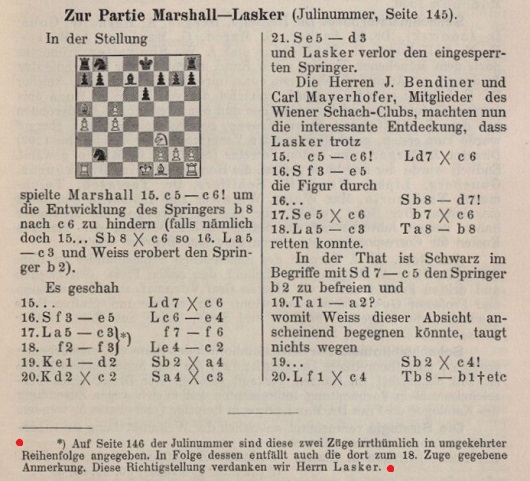
From the foregoing it can be concluded that the correct move-order is 17 Bc3 f6 18 f3.
Nevertheless, the would-be sequence 17 f3 f6 18 Bc3 has been seen in print for an astonishingly long time. Marshall included the game on pages 63-64 of Marshall’s Chess “Swindles” (New York, 1914). He gave Teichmann’s annotations, which meant that the wrong move-order from the BCM was published again. The missed opportunity was passed over in silence, although it was mentioned on pages 39-40 of Marshall’s My Fifty Years of Chess (New York, 1942):
“18 B-B3? Not the best. More exact was PxB PxKt 19 B-B3 KtxRP 20 RxKt with an easy win.”
In recent decades, the game has frequently been republished. K. Whyld gave the wrong move-order on page 93 of The Collected Games of Emanuel Lasker (Nottingham, 1998), even though Rosenthal’s tournament book was specified as the source. The right move-order was published by Egon Varnusz on page 206 of Emanuel Lasker, Volume 1, Games 1889-1907 (Budapest, 1998), but that prompted the comment “the Varnusz book doesn’t even get the move-order right” from Tim Harding in his Kibitzer column at the Chess Café, January 2000.
On pages 61-65 of Paris 1900 (Nottingham, 1986) Jimmy Adams included the correct move-order 17 Bc3 f6 18 f3 from the tournament book by Rosenthal but added notes from My Fifty Years of Chess, Teichmann in the BCM and the Deutsche Schachzeitung. John Hilbert put the wrong move-order when giving the game on pages 230-233 of Young Marshall (Olomouc, 2002), although at least two of his five sources had the correct one.
A second discrepancy in the game-score is sometimes seen:

Position after 28 Kb2
Here, Lasker played 28...Rc5, protecting his d-pawn. In both of Marshall’s above-mentioned books, as well as the works by Adams and Varnusz, the move 28...Rc7 is given instead. That wrong move is currently also present in the Chessbase Online Database, NICBase Online, 365chess.com and chessgames.com, but at least the first three of them have the correct order for White’s 17th and 18th moves.
On pages 789-791 of Emanuel Lasker Denker, Weltenbürger, Schachweltmeister by Richard Forster, Stefan Hansen and Michael Negele (Berlin, 2009) the annotations from Marshall’s My Fifty Years of Chess were presented in a German translation, which meant that both cases of incorrect moves discussed above were included. In addition, 52...g4 was given instead of the actual move, 52...b5.
Rosenthal’s tournament book was correct about all three points discussed above, although it had errors elsewhere in the game-score. Thus none of the books that I have mentioned had a fully accurate version of the game. It should read:
1 d4 d5 2 c4 e6 3 Nc3 Nf6 4 Bg5 c6 5 e4 dxe4 6 Nxe4 Bb4+ 7 Nc3 c5 8 a3 Bxc3+ 9 bxc3 Qa5 10 Bd2 Ne4 11 Nf3 Nxc3 12 dxc5 Nxd1 13 Bxa5 Nb2 14 a4 Bd7 15 c6 Bxc6 16 Ne5 Be4 17 Bc3 f6 18 f3 Bc2 19 Kd2 Nxa4 20 Kxc2 Nxc3 21 Nd3 Nd5 22 cxd5 exd5 23 Nc5 b6 24 Bb5+ Kf7 25 Na4 Nc6 26 Nc3 Rhc8 27 Rhd1 Ne7 28 Kb2 Rc5 29 Bd3 a5 30 Na4 Rc6 31 Rac1 Rb8 32 Rxc6 Nxc6 33 Rc1 Ne5 34 Rc7+ Ke6 35 Bb5 g5 36 Ra7 d4 37 Ra6 Kd5 38 Kc2 Rb7 39 Ra8 Nc6 40 Kd2 Nb4 41 Rd8+ Ke5 42 Nb2 Rc7 43 Nc4+ Kf5 44 Rxd4 Rc5 45 Be8 Rd5 46 Ne3+ Ke5 47 Nxd5 Kxd4 48 Nxb4 axb4 49 Bf7 f5 50 Bg8 h5 51 Bf7 h4 52 h3 b5 53 Be8 Kc4 54 Bd7 b3 55 Bxf5 Kb4 56 Bd3 b2 57 Kc2 Ka3 58 Kb1 Resigns.’
9529. Edgard Tchélébi (C.N. 9519)
Further information about Edgard Tchélébi has been received from Dominique Thimognier (Fondettes, France).
Below, firstly, is his obituary on page 140 of Europe Echecs, July 1963:
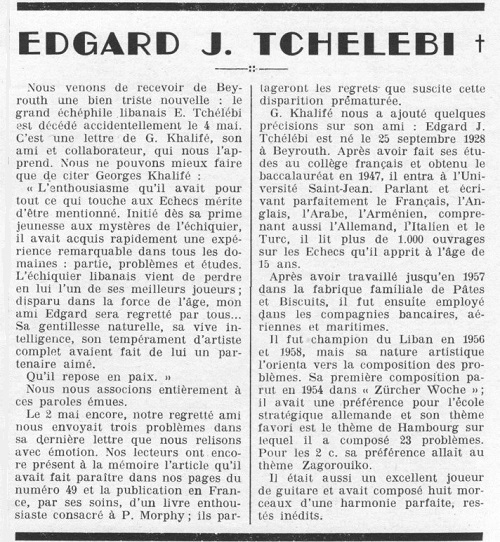
A photograph was published on page 172 of Europe
Echecs, July 1964, in connection with the Concours
mémorial
Edgard J. Tchélébi, a problem competition on the
Hamburg theme:
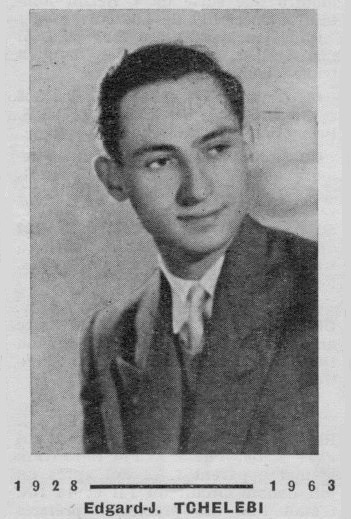
Mr Thimognier has also provided a small PGN file of games by Tchélébi which were published in Europe Echecs and L’Echiquier de France. From the entertaining play some positions are extracted here:
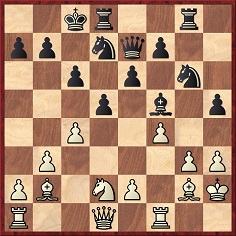
After 16 Nd2
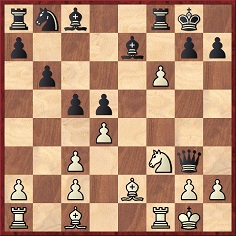
After 12...Qxg3
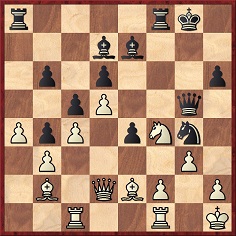
After 26 g3

After 12...b4
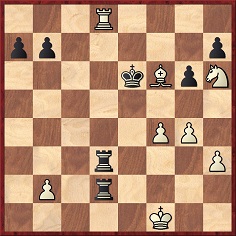
After 33...Ke6.
9530. A letter from Korchnoi
Timothy J. Bogan (Chicago, IL, USA) writes:
‘I recently came across a letter from Victor Korchnoi in response to fan mail which I sent him during the 1978 world chess championship match. I never expected a personal response, so it was a great and pleasant surprise.’
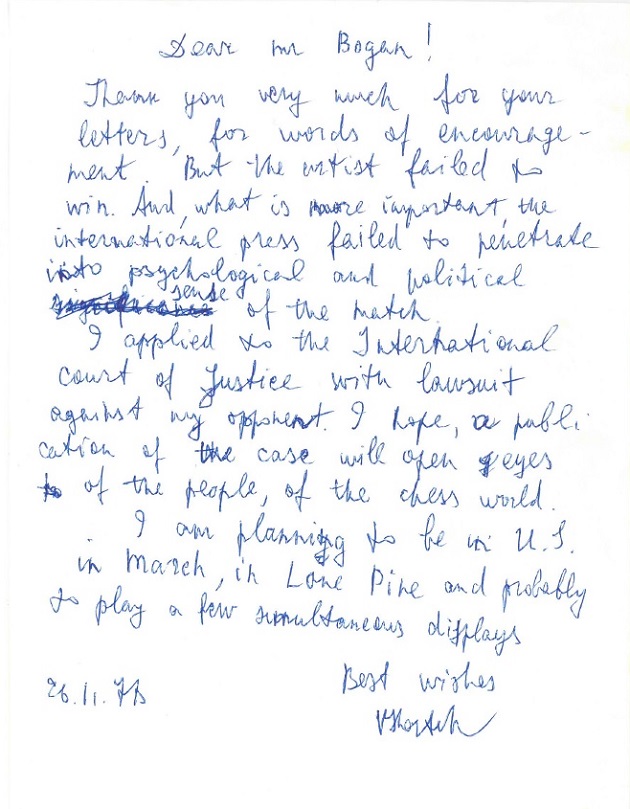
9531. Spassky v Fischer, 1972 and vox populi

C.N. 9146 referred to Mary Kenny’s breezy despatches from Reykjavik in the London Evening Standard during the 1972 Spassky v Fischer world championship match. In addition to her yellow, or yellowish, journalism, the newspaper welcomed comment of the same hue on its correspondence pages. It is doubtful whether any previous chess event offered so many people an opportunity to ‘have their say’ despite being even less well informed than most of the journalists.
On 1 August 1972 A. Hawson (London) felt the need to respond in the Evening Standard (‘Via-Dictate-A-Letter’) to what a correspondent had said on 27 July and, in particular, ‘to take issue with the suggestion that the £50,000 donated by Mr Slater ... should have been given to the British Olympics Appeal. The publicity now being given in the British Press to the great game of chess is long overdue and I, for only one, am very glad ...’, etc., etc. On the same page, Ewart Milne (Bedford) recalled Mary Kelly’s description of Fischer as ‘a social illiterate, a political simpleton, a cultural ignoramus and an emotional baby’ and proffered this rejoinder: ‘So was Napoleon Bonaparte, but he changed what is called the art of war forever.’ Mr Milne’s contribution ended: ‘Personally I cannot see anything abnormal or even objectionable about Bobby’s tantrums. How about Nastase? Or is it only Americans who are hated when they show off?’ That red rag elicited a letter in the 4 August 1972 edition from Teresa Malik (London). Her analysis of the Match of the Century seamlessly incorporated a description of her credentials for the task:
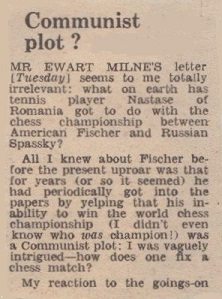

From Iceland, meanwhile, Mary Kenny continued to chew over almost every aspect of the chess match except the chess, and the eventual cessation of her reports was itself a topic for comment. The following was published on 16 August 1972:

Letter-writers know that submissions in colourful language (‘despatch her to Terra [sic] del Fuego’) are more likely to reach the presses. To that end, ‘lock them up and throw away the key’ and ‘hanging is too good for them’ have always been serviceable entreaties. Then as now, a measured analysis of pros and cons is less likely to attract an editor’s eye than a spree of fustian ignorance. Now but not then, the Internet allows anyone to by-pass whatever barriers, however low, editors put in place for participation in a discussion. There are pros and cons there too.
Chess magazines in 1972 were relatively restrained in their strictures on Fischer’s conduct and, with so much chess play to cover, little space was available for disquisitions by the unknown. As the Reykjavik frenzy receded, however, so-called debates came back into fashion. Criticizing ‘free speech in action’ may not be regarded as good form, but Wolfgang Heidenfeld had no such inhibitions on page 257 of CHESS, June 1973, in a letter headed ‘Rabbits and Nonsense’:
‘Your correspondence about simultaneous display etiquette is becoming boring, especially as most of the views represented are those of rabbits who do not even know the rules.’
Heidenfeld died long before the Internet age. What he would have written about vox populi today is neither difficult nor unpleasant to imagine.
9532. Endgame
Frank Brady (New York, NY, USA) informs us that his biography of Fischer, Endgame (New York, 2011 and 2012), has appeared in Czech, Dutch, German, Icelandic, Italian, Japanese and Russian, and that a Spanish edition is in preparation.
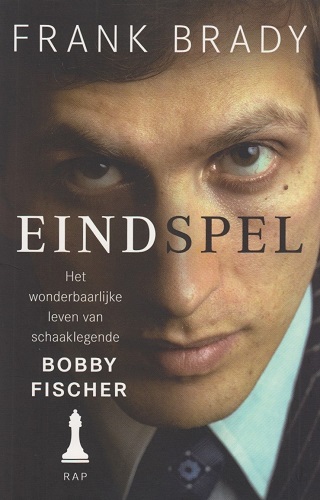
9533. Photographic archives (12)

Ulf Andersson
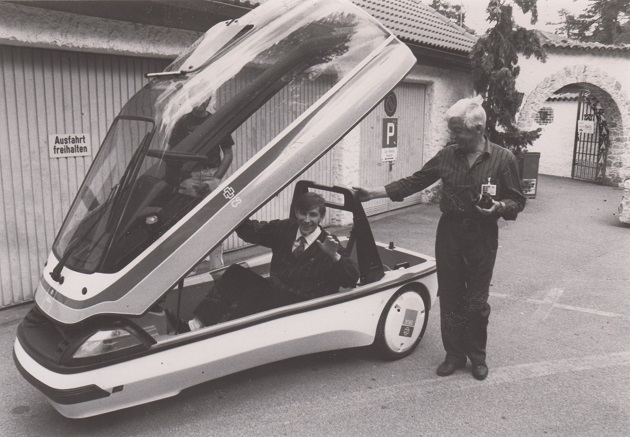
Evgeny Bareev (seated)

Alexei Shirov
9534. Lasker v
Capablanca, St Petersburg, 1914 (C.N. 7846)
From the Preface to The Golden Dozen by Irving Chernev (Oxford, 1976):
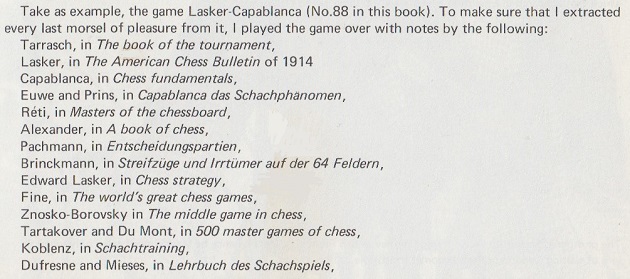

Below is the Lasker v Capablanca game with annotations by another master, Nimzowitsch, on pages 36-39 of volume one of Schachmeisterpartieen des Jahres 1914 by Bernhard Kagan (Berlin, 1914):
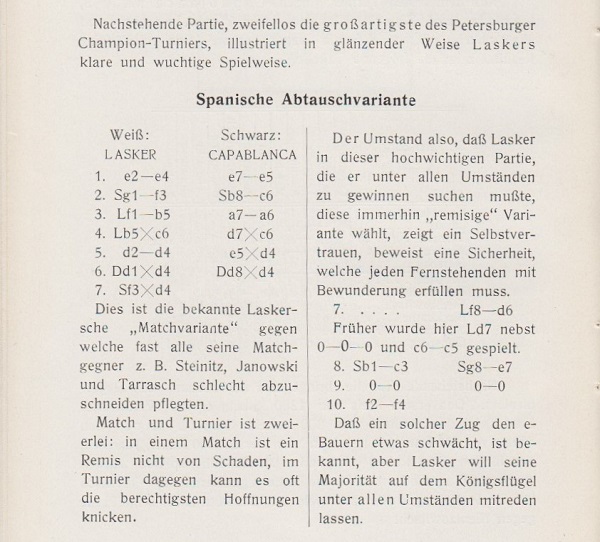
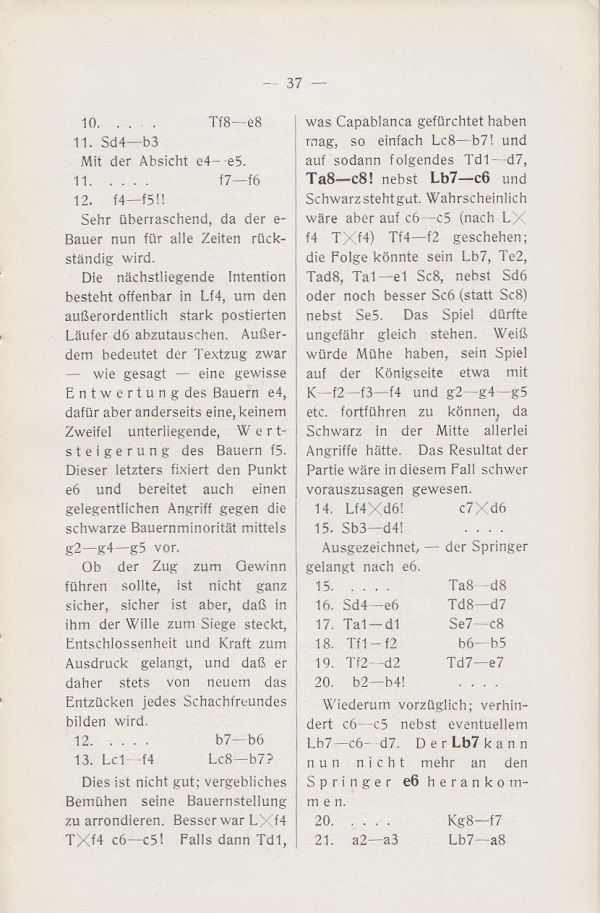
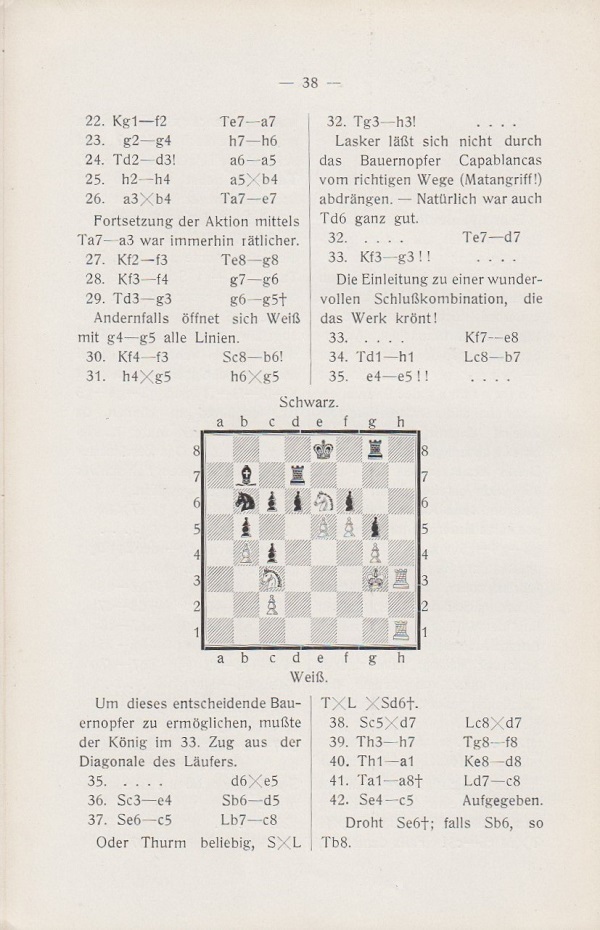

1 e4 e5 2 Nf3 Nc6 3 Bb5 a6 4 Bxc6 dxc6 5 d4 exd4 6 Qxd4 Qxd4 7 Nxd4 Bd6 8 Nc3 Ne7 9 O-O O-O 10 f4 Re8 11 Nb3 f6 12 f5 b6 13 Bf4 Bb7 14 Bxd6 cxd6 15 Nd4 Rad8 16 Ne6 Rd7 17 Rad1 Nc8 18 Rf2 b5 19 Rfd2 Rde7 20 b4 Kf7 21 a3 Ba8 22 Kf2 Ra7 23 g4 h6 24 Rd3 a5 25 h4 axb4 26 axb4 Rae7 27 Kf3 Rg8 28 Kf4 g6 29 Rg3 g5+ 30 Kf3 Nb6 31 hxg5 hxg5 32 Rh3 Rd7 33 Kg3 Ke8 34 Rdh1 Bb7 35 e5 dxe5 36 Ne4 Nd5 37 N6c5 Bc8 38 Nxd7 Bxd7 39 Rh7 Rf8 40 Ra1 Kd8 41 Ra8+ Bc8 42 Nc5 Resigns.
As listed on page 226 of Aron Nimzowitsch On the Road to Chess Mastery, 1886-1924 by Per Skjoldager and Jørn Erik Nielsen (Jefferson, 2012), Nimzowitsch’s notes were published in Johannes Behting’s column in Rigasche Rundschau, 6 June 1914 (new style). Mr Skjoldager has forwarded us the full page:
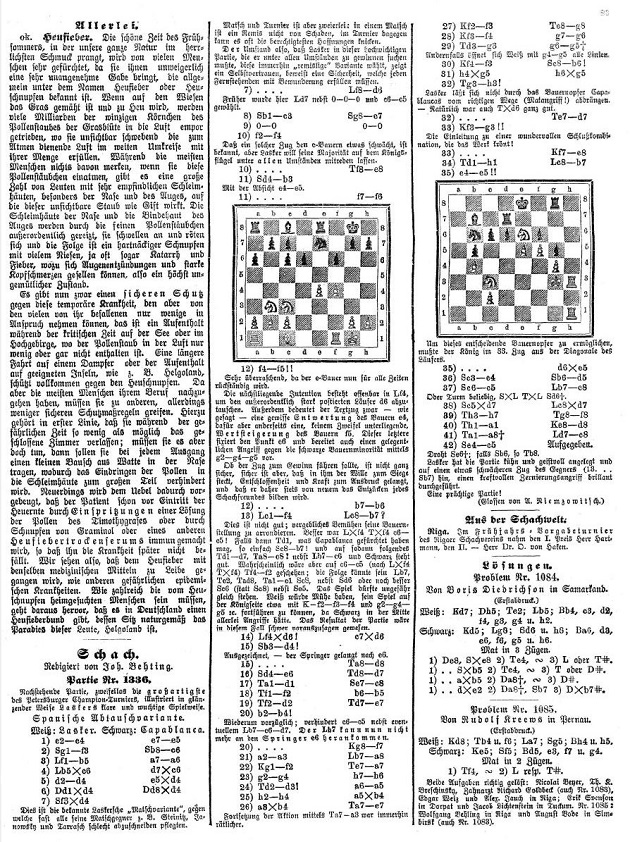
The most extensive set of notes to the Lasker v Capablanca game that we have seen in recent years is on pages 177-181 of John Nunn’s Chess Course (London, 2014).
9535. A win by Dr G. Marseille
Wanted: information about a game published on pages 104-105 of Schachmeisterpartien des Jahres 1914 (volume two) by Bernhard Kagan (Berlin, 1915):
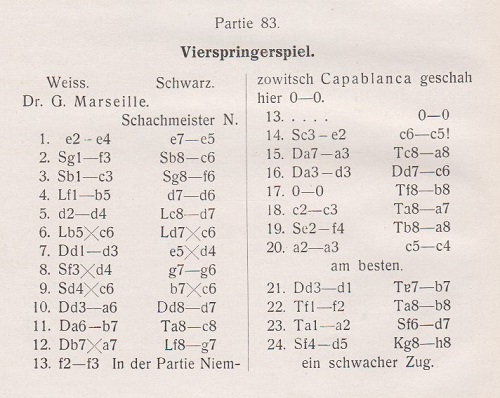
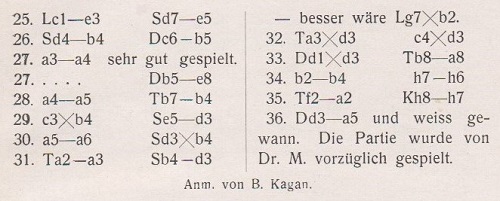
1 e4 e5 2 Nf3 Nc6 3 Nc3 Nf6 4 Bb5 d6 5 d4 Bd7 6 Bxc6 Bxc6 7 Qd3 exd4 8 Nxd4 g6 9 Nxc6 bxc6 10 Qa6 Qd7 11 Qb7 Rc8 12 Qxa7 Bg7
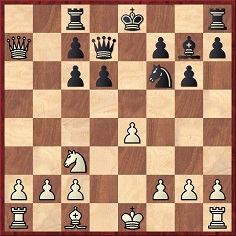
13 f3 O-O 14 Ne2 c5 15 Qa3 Ra8 16 Qd3 Qc6 17 O-O Rfb8 18 c3 Ra7 19 Nf4 Rba8 20 a3 c4 21 Qd1 Rb7 22 Rf2 Rab8 23 Ra2 Nd7 24 Nd5 Kh8 25 Be3 Ne5 26 Nb4 Qb5 27 a4 Qe8 28 a5 Rxb4 29 cxb4 Nd3 30 a6 Nxb4 31 Ra3 Nd3 32 Rxd3 cxd3 33 Qxd3 Ra8 34 b4 h6 35 Ra2 Kh7 36 ‘Dd3-a5’ and White won.
The first note mentions the intriguing duplication of the opening 12 moves of Nimzowitsch v Capablanca, St Petersburg, 1914 – game 25 in My Chess Career and, as mentioned in C.N. 5461, a game described by Alekhine as ‘sensational’.
A detail regarding the two volumes of Kagan’s work (Berlin, 1914 and Berlin, 1915): the respective title pages had the spellings Schachmeisterpartieen and Schachmeisterpartien.
9536. Small magazines (C.N.s 6132 & 6181)
Vitaliy Yurchenko (Uhta, Komi, Russian Federation) draws attention to a bi-monthly Russian-language chess magazine Филидор (Philidor), which was published in Omsk from 1993 to 1995 with a print-run of 150 copies. At least 14 issues appeared.
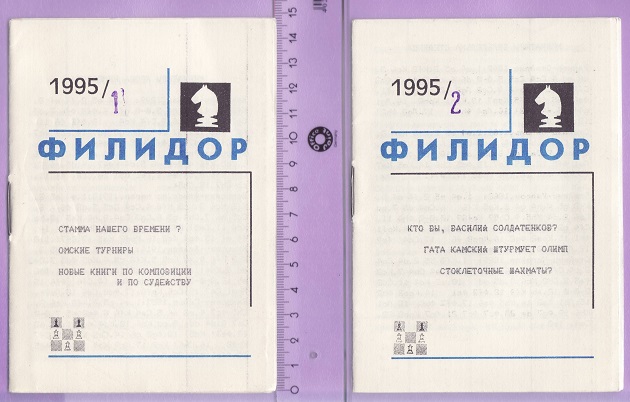
9537. Gibaud v Lazard
Page xxiv of The Blue Book of Charts to Winning Chess by Arthur M. Stevens (South Brunswick and New York, 1969) took a discredited game (Gibaud v Lazard) and added more fiction. Other imprecision includes the misspelling of Monsieur six times:
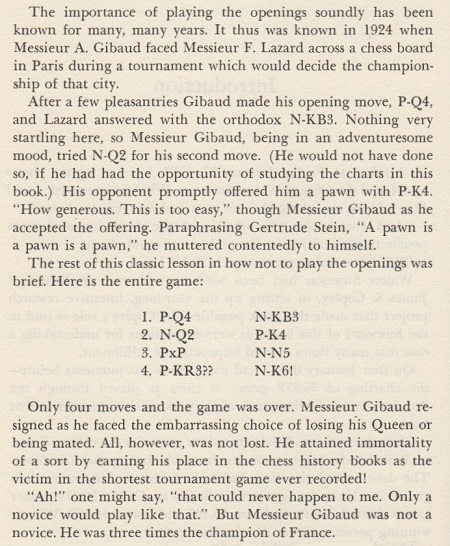
9538. How many people play chess?
Two little pensées have recently been added to Chess Jottings:
- In chess journalism how often can numbers above fifty or a hundred be believed, let alone figures in the millions?
- About chess, studies show that 100% of writers claiming what studies show are 100% without studies to show.
From the unsigned Foreword to Arthur M. Stevens’ The Blue Book of Charts to Winning Chess (C.N. 9537), pages ix-x:
‘Looked upon with great favor, the top Soviet players are rewarded with fringe benefits such as superior living accommodations and are subsidized with a state-paid salary.
Is it any wonder, then, that today in Russia there are 625 registered chessplayers per 100,000 population as compared to two serious players per 100,000 population in the United States? In all, some 14,000,000 persons are chess devotees in Russia, and less than 4,000,000 in America.
True, it has been estimated that as many as 15 million Americans play chess. But, Stevens notes, “Most of them play chess the way most people play bridge – not very seriously.”’
As mentioned in C.N. 9537, Stevens’ book was published in 1969.
An article by Xu Jialiang on pages 6-7 of the November 1979 CHESS was entitled ‘200 Million Potential Chess Champions Join the Lists’ and offered the following:
‘For the truth is that Chinese chess players have not been dozing – but simply playing a different game.
In fact, it is estimated that almost a quarter of China’s 900 million or so inhabitants are keen chess players – as have been generations of Chinese since the time of Confucius 2,500 years ago.
In those days, they played a game called “wei qi”...’
Concerning what CHESS termed ‘our chess’, the article added:
‘There are now estimated to be about 100,000 international chess players in China.’
And:
‘The Chinese Chess Association has more than 5,000 members, all of whom are up to provincial tournament standard.’
Another passage picked at random, from an obvious source, is on page 8 of Alpha Teach Yourself Chess in 24 Hours by Zsuzsa Polgar, Hoainhan “Paul” Truong and Leslie Alan Horvitz (Indianapolis, 2002/2003):
‘Today, according to recent polls, 25-30 million people play chess in the United States alone. Worldwide, chess is played in more than 150 countries, and it is estimated that hundreds of millions of people know how to play chess.’
Many other claims about the number of chessplayers, whether worldwide or in particular countries, could easily be cited, all lacking any indication as to where the figures originated. Already above, we have seen ‘it has been estimated that ...’, ‘it is estimated that...’ and ‘there are now estimated to be ...’, as well as ‘according to recent polls’. Other airy options include ‘It has been shown by studies that ...’, and these impersonal and passive constructions help circumvent the need to identify the estimators, pollsters and studiers.
Not that such pseudo-corroborative expressions are needed at all. The following ipse dixit comes from an interview with Kirsan Ilyumzhinov by Tim Redman on page 36 of Chess Life, November 2002:
‘Right now half a billion people play chess. I want it to grow to a billion.’
The published interview does not record that Mr Redman
sought substantiation of the statistics, or an explanation
of what ‘play chess’ means.
From another interview with the FIDE President, this appeared on page 176 of The Chess Artist by J.C. Hallman (New York, 2003):
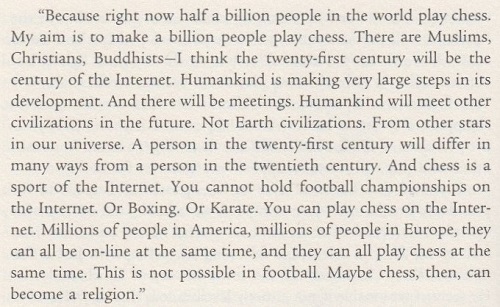
Any future C.N. items on this topic will continue to focus on claims recorded in books and magazines, and not least claims from former times. When, for instance, was an estimate of the number of chessplayers worldwide first put forward?
9539. Overstepping the time-limit
Chess and Time includes reports on leading players who seldom, if ever, lost on time in tournament or match play. An addition comes from page 11 of The Life and Games of Mikhail Tal by M. Tal (New York, 1976):
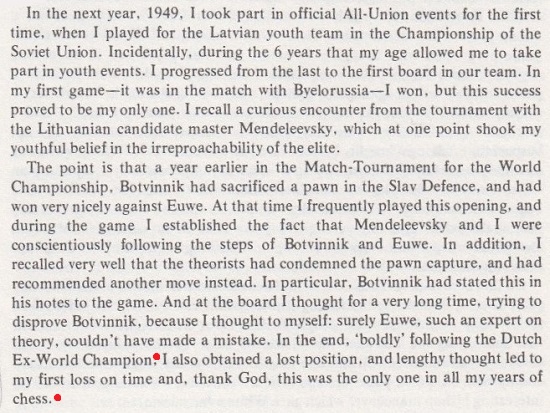
The passage is on pages 20-21 of the 1997 Cadogan edition of Tal’s book.
When the game between Mendeleevsky and Tal (Riga, June 1949) was given on pages 12-13 of Mikhail Tal Tvortshestvo 1949-1961 (Riga, 1996) Black’s loss on time was mentioned:


9540. Zukertort v Blackburne
With regard to Zukertort v Blackburne, London, 1883, another work which gave 31 Bxe5+ two exclamation marks, even though White had a forced mate in seven with 31 Rg8+, is The Macmillan Handbook of Chess by I.A. Horowitz and F. Reinfeld (New York, 1956). See page 94.
9541. Capablanca v Thomas
Michael Clapham (Ipswich, England) has forwarded a cutting from the Daily Telegraph, 15 August 1919:
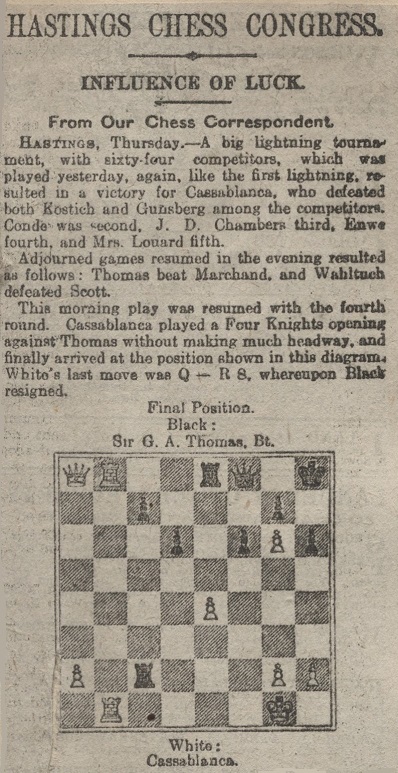
Our correspondent adds that the newspaper gave Capablanca’s name correctly in its reports on other days.
C.N. items on this famous game have been brought together in a new feature article, Capablanca v Thomas, Hastings, 1919.
9542. Weston-super-Mare, 1922
The participants in the West of England Chess Festival, Weston-super-Mare, 15-22 April 1922:
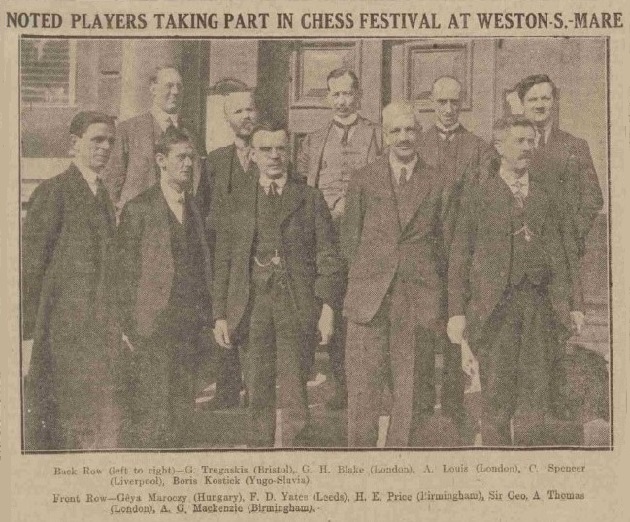
Source: Western Daily Press, 20 April 1922, page 3.
9543. Small magazines (C.N.s 6132, 6181 & 9536)
Concerning Ajedrez Chileno, discussed in C.N. 6132, we are grateful to the Cleveland Public Library for the following (the measurement being in inches):
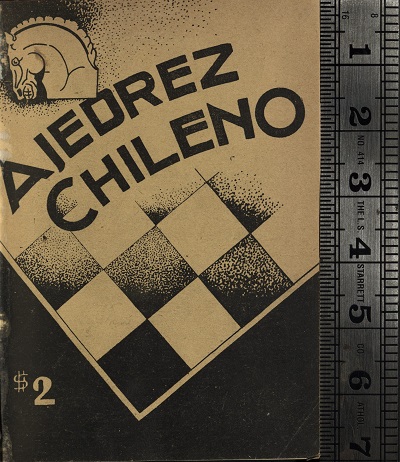
9544. Nimzowitsch explained
Anyone finding Nimzowitsch’s games and writings difficult to understand may wish to refer to the chapter about him in The Dynamics of Chess Psychology by Cary Utterberg (Dallas, 1994). Below is the concluding paragraph, on page 131:
‘When responsibility is first encountered existentially, the resulting anxiety can be particularly troubling (a dilemma akin to Ivan Karamazov’s lament that, “Everything is permitted”, – a recognition that there’s no objective ground of morality, but one accompanied by a nagging feeling that there’s still a universal legislator, only he’s not on the job). In such cases, anxiety tends to manifest itself as lack of direction, indecision, and uncertainty. As a consequence, Nimzovich – one of the first masters to experience responsibility – oscillated between employing the phenomenon and generalizing its insights into strategic laws – entities that can at best reflect the radically subjective nature of responsibility. This is why Nimzovich was the last great law-giver of chess – because leading masters since his day have moved beyond anxiety to a deeper, more authentic relation with responsibility.’
9545. Winter is Coming by Garry Kasparov
Garry Kasparov’s track-record as a writer may generously be called patchy. The early triumph of The Test of Time (Oxford, 1986) was followed by the calamitous Child of Change (London, 1987). Kasparov Against the World, co-written with Daniel King (New York, 2000), received warm plaudits, but in Kasparov’s Predecessors series the first volume (London, 2003) was particularly shameful for its lack of historical rigour. His indifference to the game’s lore was highlighted in How Life Imitates Chess (New York and London, 2007).
Written just after he retired from serious chess play, Reflections on Garry Kasparov suggests certain reasons (some book-related, including his lamentable choice of associates) for the decline in his general reputation in the chess world, and since 2005 Kasparov’s focus has been on Russian and international politics. That has now resulted in Winter is Coming by Garry Kasparov with Mig Greengard (London, 2015), a 290-page work subtitled ‘Why Vladimir Putin and the enemies of the free world must be stopped’.
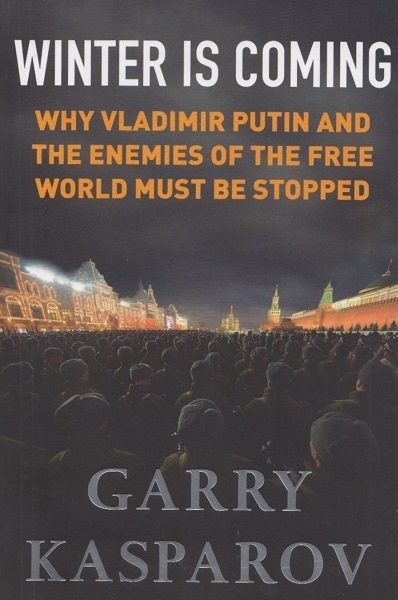
On page 286 some of the index entries for ‘Putin, Vladimir’ convey the book’s thrust: ‘aggressive actions summary (2008)’; ‘anti-democratic actions summaries’; ‘background/KGB and’; ‘comparisons to other dictators’; ‘corruption and’; ‘Hitler comparisons and’; ‘mafia comparisons and’; ‘people’s unimportance to’; ‘popularity myth’; ‘recommendations on ending his regime’.
Fortunately, the book has little if anything in the two areas of chess – history and politics – which have caused so much damage to Kasparov’s standing through his predisposition towards inaccurate and unsubstantiated statements. There are, though, many notable references to the game, such as the following:
- ‘As much as I loved chess and as much as chess had done for me, I had always known that there were more important things in life. I was lucky that my “disloyalty” to the chess goddess Caissa rarely cost me as dearly at the chessboard as it might have.’ (Page 25)
- ‘In October [2000], I had my first world championship title defense in five years, against my compatriot Vladimir Kramnik. I arrived in London in great shape, full of ideas and confidence. A month later I had been defeated in a title match for the first time, and without winning a single game. Kramnik had outprepared me and outplayed me and I was a victim of my own complacency after 15 years at the top. It was a crushing experience and, at 37, I briefly considered retirement for the first time. But my desire to prove I was still the best player in the world was too strong and I would retain my number one ranking until I retired in 2005.’ (Page 106)
- ‘Despite my many sporting successes for the glory of
the motherland, my ethnicity occasionally appeared in
questions about my loyalty during my rivalry with
Karpov, who was of “respectable stock” from the Russian
heartland while I was an “explosive combination”. And
ever since I became active in the anti-Putin movement
there has been a dramatic increase in the number of
times I have been called “Weinstein”, my father’s name,
which was exchanged for my mother’s Armenian family name
not long after my father died when I was seven.’ (Page
124)
- ‘It’s not uncommon, in our age, for someone to retire while still at the top, but I’m a man who needs a goal, and who wants to make a difference. My accomplishments and contributions are for others to judge, but I felt that I was no longer playing an essential role in chess. Reclaiming the unified world championship was out of reach due to political chaos in the chess world, so I was reduced to unfulfilling repetition.’ (Page 136)
- ‘When I retired from chess I had been told that my fiery, undiplomatic nature would make me unsuitable for political activism. I had been an aggressive attacker at the chessboard and a fractious rebel in the chess world even as world champion, so how would I adapt to the subtle world of alliances and diplomacy? I would like to think that in this I met politics halfway. I listened and showed respect – half the time. I argued with colleagues who knew more and who had done more because I wanted to push us all to a new level of cooperation and confrontation. It was the only way to build a coalition that included former prime ministers and would-be Bolsheviks. And when it came time to march, my loud voice and hard head were assets, not weaknesses.’ (Page 151)
- ‘I have a long and complicated résumé, so I’m used to hearing all sorts of things [in introductions during media appearances and at lectures] ... They are always kind and usually flattering, but often they contain all sorts of spurious information about me gleaned from a quick Google search. I often have to follow up with a quick set of corrections and joke that I’m always interested in these introductions because I learn so many new things!
“Garry Kasparov, Russian human rights activist and former world chess champion” shouldn’t be too hard, no?’
... The one title I truly dislike is one I hear quite often: “Garry Kasparov, former Russian presidential candidate.” This is not only inaccurate, but it is misleading in a damaging way.’ (Pages 175-176)
Nothing would induce us to comment on Kasparov’s political beliefs or on how they are set out and backed up in his book. On the purely technical question of prose quality, we gladly observe that Winter is Coming is the best book that Kasparov has produced.
9546. How Life Imitates Chess
From the ‘About the author’ page at the end of Kasparov’s Winter is Coming:
‘His 2007 book, How Life Imitates Chess, has been published in 26 languages.’
Has any other chess, or chess-related, book been translated so many times? We should like to receive (or, à défaut, to compile) a list of the 26 languages, and to know which of the translations have corrected the various errors in the original English edition. An example mentioned in the feature article Kasparov’s How Life Imitates Chess concerns the spurious Spielmann quotation.

9547. Books on Spassky
Carlos Ubilla González (Santiago, Chile) enquires about biographies or annotated games collections concerning Spassky.
A list of books about him was given in C.N. 2909 and has just been added, with updates, to the feature article Boris Spassky.
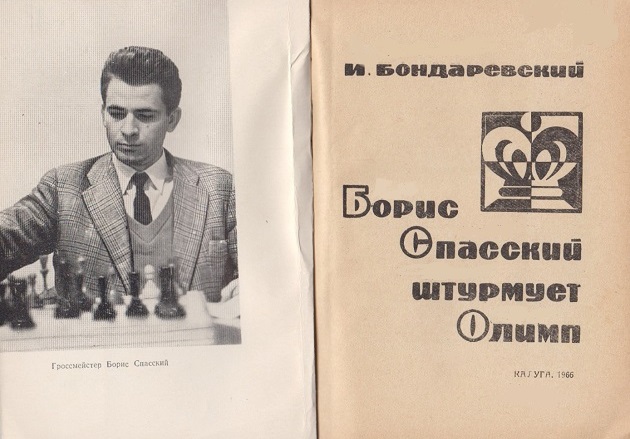
Our correspondent’s query brings to mind a paragraph from page 332 of Impact of Genius by R.E. Fauber (Seattle, 1992) which we have doggedly approached from every angle without making sense of it:
‘The paradox of Boris Spassky is that it is hard to remember any of the plentiful immortal games he has created. There is to Spassky’s play a lightness, the deft and delicate touch which makes just the right brush stroke. It can never be repeated nor can it be improved upon. This endows it with inconsequentiality. Spassky plays last year’s beautiful spring – gorgeous but past.’
9548. ‘Mozart symphony’
Ivor Goodman (Stevenage, England) asks about the earliest occurrence of the term ‘Mozart symphony’ to describe a chess game. He draws attention to a remark by Reuben Fine on page 162 of Chess Marches On! (New York, 1945):
‘The following game, played in a recent Dutch tournament, is as graceful and pleasing as a Mozart symphony. Euwe has produced a masterpiece of force and elegance.’
We note, firstly, that Fine originally published those words on page 76 of Chess Review, March 1943 when introducing the game in question. In both the magazine and the book, Fine named Black as ‘Van Stenis’, instead of van Steenis. Chess Review merely stated that the game was ‘played in a recent Dutch tournament’. Chess Marches On! referred to the occasion as ‘The Netherlands, 1942’, and databases have followed suit, although Al Horowitz correctly labelled the game ‘Amsterdam, 1941’ on page 505 of Chess Openings Theory and Practice (New York, 1964).
The score was published on page 5 of De Telegraaf, 8 September 1941:

1 d4 d5 2 c4 c6 3 Nf3 Nf6 4 Nc3 e6 5 e3 a6 6 c5 Nbd7 7 b4 Ne4 8 Nxe4 dxe4 9 Nd2 f5 10 f3 exf3 11 Qxf3 Nf6 12 Bc4 Be7 13 O-O Nd5 14 e4 Nxb4 15 Bb2 Nc2 16 exf5 O-O 17 Rad1 Nxd4 18 Qg4 Bxc5 19 Ne4 Ba7 20 f6 g6 21 Ng5 c5 22 f7+ Kg7 23 Qf4 Bb8 24 Rxd4 cxd4 25 Bxd4+ e5 26 Bxe5+ Bxe5 27 Qxe5+ Kh6 28 Ne4 b5 29 g4 Bxg4 30 Nf6 Bf5 31 Ng8+ Rxg8 32 fxg8(Q) Qg5+ 33 Qg3 Resigns.
A few of Fine’s comments on page 77 of the March 1943 Chess Review are notable:
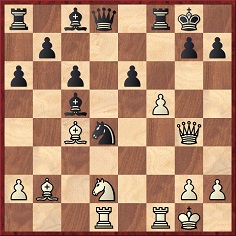
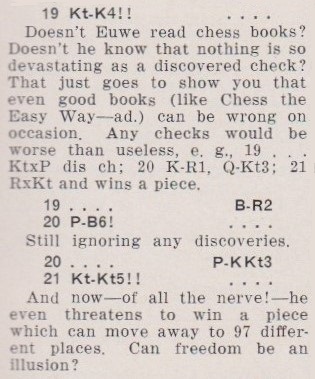
As discussed in C.N. 8726, Fine had called discovered check ‘the dive-bomber of the chess board’ on page 112 of his book Chess The Easy Way (Philadelphia, 1942). For Nimzowitch’s ‘laziest king’ remark about double check, see C.N. 8652.
Concerning ‘Mozart symphony’, we recall no earlier use of the expression to describe a chess game. It became especially familiar in 1972 after the sixth game in the Spassky v Fischer match. The following, for instance, was on page 8 of the Sunday Times, 30 July 1972:

This report by a ‘Sunday Times Chess Expert’ stated regarding Fischer’s victory:
‘It was so beautifully played that it moved the Argentine grandmaster, Miguel Majdorf [sic], to say it reminded him of a symphony by Mozart, although he did not specify which.’
C.N.s 7645, 7662 and 9172 give citations for many players who have been described as the Mozart of chess.
9549. Gossip
Page 97 of Samuel Lipschütz A Life in Chess by Stephen Davies (Jefferson, 2015) quoted colourful passages about G.H.D. Gossip from the New York Times, 16 June 1889 and the New York Sun, 25 November 1890, page 3:

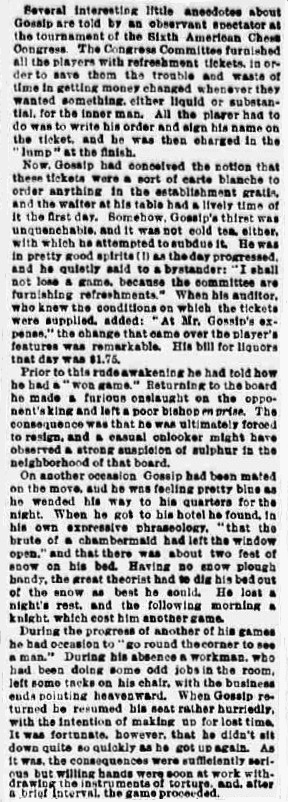
9550. Korchnoi and castling
From Thomas Niessen (Aachen, Germany):
‘Chess Jottings includes C.N. 795, which deals with Korchnoi’s well-known uncertainty on castling in the 1974 Candidates’ Final against Karpov. You show that after Black’s 17th move in the 21st match-game, Korchnoi wrote on page 161 of Chess is My Life (London, 1977):
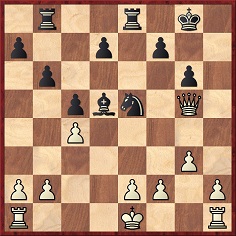
Position before 18 O-O
Concerning Korchnoi’s statement that “out of the two and a half thousand games that I had played, there had never been an instance where it had been necessary for me to castle when my rook was attacked ...”, I note the game Korchnoi v Sherbakov, Poltava, 1956, which began 1 d4 Nf6 2 c4 g6 3 Nc3 Bg7 4 g3 O-O 5 Bg2 d6 6 Nf3 c5 7 d5 e5 8 dxe6 Bxe6 9 Ng5 Bxc4 10 Bxb7 Nbd7 11 Bxa8 Qxa8
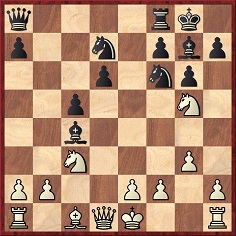
Korchnoi played 12 O-O.
I have also found two games pre-dating 1974 in which Korchnoi’s opponents castled when the rook was under attack. The first, Troianescu v Korchnoi, Bucharest, 1954, opened 1 e4 c5 2 Nc3 Nc6 3 g3 Nf6 4 Bg2 e6 5 Nge2 d5 6 exd5 exd5 7 d4 Bg4 8 h3 Be6 9 Bg5 h6 10 Bxf6 Qxf6 11 Nxd5 Bxd5 12 Bxd5 O-O-O 13 Bxc6 Qxc6.

Here, 14 O-O was played by Troianescu.
The second game is Smyslov v Korchnoi, Moscow, 1960, which began 1 e4 c5 2 Nf3 d6 3 d4 cxd4 4 Nxd4 Nf6 5 Nc3 g6 6 Be2 Bg7 7 Nb3 Nc6 8 g4 b6 9 f4 Bb7 10 Bf3 O-O 11 h4 a5 12 a4 Nb4 13 h5 d5 14 e5 Nxg4 15 Nd4 Nh6 16 hxg6 fxg6 17 Ne6 Qd7 18 Nxf8 Rxf8 19 Nb5 d4 20 Bxb7 Qxb7.
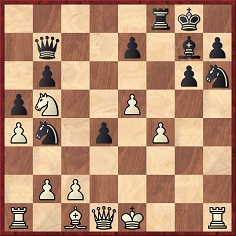
Smyslov played 21 O-O.’
The full scores are on, respectively, pages 37, 20 and 64 of Korchnoi’s Chess Games edited by David Levy and Kevin O’Connell (Oxford, 1979).
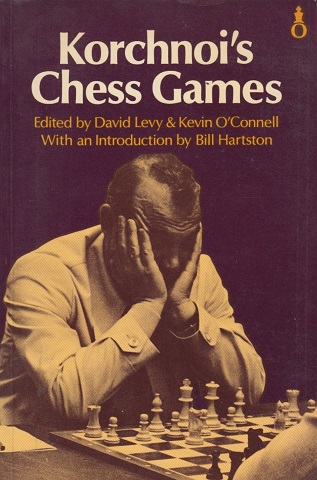
The Introduction by Hartston includes these observations (page vii):
‘Among the great players of the world Viktor Korchnoi is unique. When he sits down to a game he brings to bear a combination of concentration, determination and energy which no other grandmaster can match. To Korchnoi chess is above all a fight. While he is playing, all that matters is the result of the game. Friendships are forgotten, problems are shelved; the struggle on the board takes absolute precedence.
This tremendous will to win makes Korchnoi’s games always interesting. Never satisfied with routine play, he seeks strategic complexity, searching for the very best move from the earliest stages of the game. Often this leads him into great time-pressure, but there Korchnoi is supreme. ...
Away from chess Korchnoi is far from being the killer he is at the board. I have always found him one of the most sociable, good-humoured and generous of grandmasters, but never expect this character to show itself during a game. ...
Having passed the age of 45, when most grandmasters are well past their prime and settling down to a less strenuous tournament life, Korchnoi plays with greater vigour than ever. To have maintained his perfectionist approach and energy-demanding style is a great achievement on its own, but to have done so with ever-improving results is almost incredible. But why ponder on the source of Korchnoi’s power when we can enjoy its fruits in his games? Study them well; he put a great deal of work into them.’
9551. Liège, 1930
Jan Kalendovský (Brno, Czech Republic) sends this item from page 1 of the Rotterdamsch Nieuwsblad, 20 August 1930:
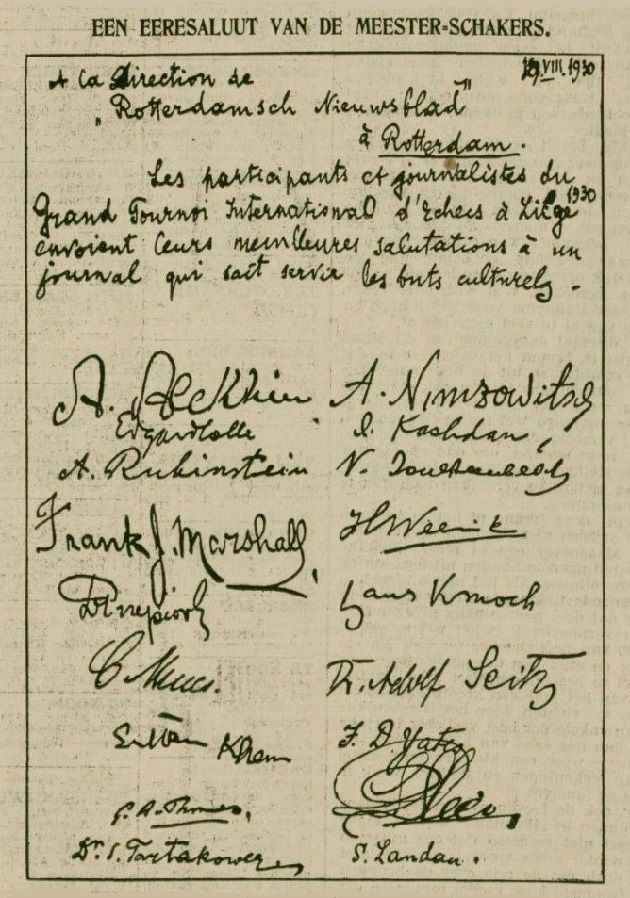
9552. Fink v Kapper
Information is sought on the game Fink v Kapper, Graz, 1932, whose conclusion was published on page 139 of The Joys of Chess by Fred Reinfeld (New York, 1961):
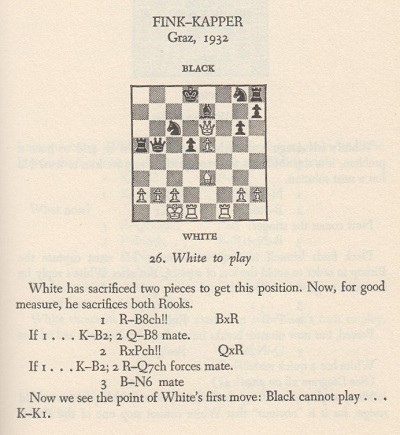
9553. Capablanca in Argentina
Eduardo Bauzá Mercére (New York, NY, USA) has submitted seven games played by Capablanca in simultaneous displays in 1911 and 1914:
José Raúl Capablanca – Guillermo Van Rees
Buenos Aires, 7 May 1911
Giuoco Piano
1 e4 e5 2 Nf3 Nc6 3 Bc4 Nf6 4 O-O Bc5 5 c3 d6 6 d4 Bb6 7 Bg5 O-O 8 d5 Ne7 9 Nh4 Nxe4 10 Qh5 Nxg5 11 Qxg5 h6 12 Qh5 Qe8 13 Nd2 f5 14 Qxe8 Rxe8 15 g3 Rf8 16 Kg2 Bd7 17 Rae1 Kh8 18 Nhf3 c6 19 dxc6 Bxc6 20 h4 e4 21 Nd4 Ng6 22 Nxc6 bxc6 23 Be2 d5 24 h5 Ne5 25 f4 Nd7 26 Rd1 Nf6 27 b4 a5 28 b5 c5 29 a4 Rad8 30 Rfe1 Rfe8 31 Bf1 Nxh5 32 Kh3 e3 33 Nf3 d4 34 cxd4 cxd4 35 Ne5 Kh7 36 Bc4 Nf6
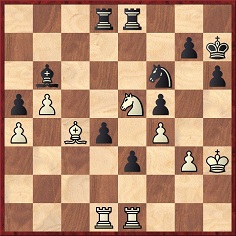
37 Bf7 Ne4 38 Bxe8 Nf2+ 39 Kg2 Rxe8 40 Rb1 d3 41 Nc4 d2
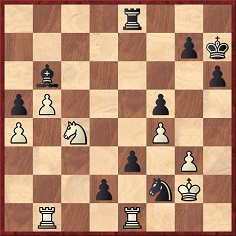
42 Nxb6 dxe1(Q) 43 Rxe1 Nd3 44 Re2 Nc1 45 Re1 Nb3 46 Nc4 e2 47 b6 Nc5 48 Kf3 Nxa4 49 Rxe2 Rb8 50 Re6 Nc5 51 Re5 Nb3 52 Ke3 a4 53 Rb5 Kg8 54 b7 Kf8 55 Ne5 a3 56 Rxb3 a2 57 Ra3 Rxb7 58 Rxa2 Rb3+ 59 Kf2 g5 60 Ra7 Rb2+ 61 Ke3 Rb3+ 62 Nd3 Rb5 63 Rh7 Rb6 64 Nc5 Rc6 65 Kd4 Kg8 66 Rd7 g4 67 Rd5 Rf6 68 Ke5 Kg7 69 Ne6+ Kg6 70 Rd6 Kf7 71 Ng5+ Resigns.
Sources: La Nación, 8 May 1911, page 10 and the Brooklyn Daily Eagle, 15 June 1911, page 2.
José Raúl Capablanca – Jorge Nollmann
Buenos Aires, 7 May 1911
French Defence
1 e4 e6 2 d4 d5 3 Nc3 Nf6 4 Bg5 Be7 5 e5 Nfd7 6 Bxe7 Qxe7 7 Nb5 Na6 8 c3 O-O 9 f4 f6 10 Nf3 fxe5 11 fxe5 Rf7 12 Bd3 Nf8 13 O-O Bd7 14 Na3 Nb8 15 Qd2 h6 16 Rf2 c5 17 Raf1 cxd4 18 cxd4 a6 19 Nc2 Nc6 20 Ne3 Qb4 21 Qd1 Kh8
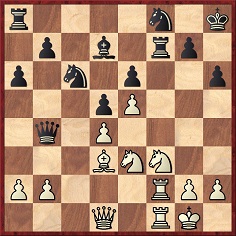
22 Bb1 Ne7 23 Nh4 Rxf2 24 Rxf2 Nh7 25 a3 Qa4 26 Bc2 Qb5 27 Rf7 Nf5 28 Nexf5 exf5 29 Bxf5 Be8 30 Re7 Qxb2 31 Bxh7 Kxh7 32 Nf5 Rc8 33 Rxg7+ Kh8 34 Rg8+ Kh7 Drawn.
Sources: La Nación, 8 May 1911, page 10 and the Brooklyn Daily Eagle, 15 June 1911, page 2.
José Raúl Capablanca – María Teresa Alonso
Buenos Aires, 29 June 1911
Ruy López
1 e4 e5 2 Nf3 Nc6 3 Bb5 d6 4 Bxc6+ bxc6 5 d4 Bg4 6 dxe5 dxe5 7 Qxd8+ Rxd8 8 Nfd2 Nf6 9 f3 Be6 10 b3 Bc5 11 Bb2 Nd7 12 Nc3 O-O 13 Nd1 f5 14 Ke2 Rf6 15 Ne3 f4 16 Nec4 Rg6 17 Kf1 Rh6
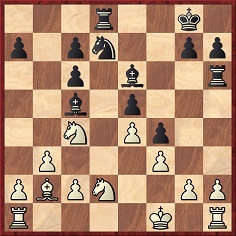
18 h4 Rh5 19 Ke2 Bf7 20 Na5 Rh6 21 Ndc4 [La Prensa did not specify which knight moved: ‘21 C4A’.] 21...Re8 22 Rad1 Bxc4+ 23 Nxc4 Bd6 24 Ba3 c5 25 Rd2 Rg6 26 Kf2 h5 27 Rhd1 Ree6 28 Na5 Kh7 29 c4 Rg3 30 Nb7 Reg6 31 Kf1 and Black resigned a few moves later.
Source: La Prensa, 30 June 1911, page 15.
José Raúl Capablanca – Manuel Augusto Molina
Buenos Aires, 29 June 1911
Danish Gambit
1 e4 e5 2 d4 exd4 3 c3 dxc3 4 Bc4 cxb2 5 Bxb2 Bb4+ 6 Nc3 Bxc3+ 7 Bxc3 Nf6 8 e5 d5 9 exf6 dxc4 10 Qe2+ Be6 11 fxg7 Rg8 12 Rd1 Qe7 13 Nf3 Nd7 14 O-O O-O-O 15 Qe3 Nb6 16 Qh6 Rxd1 17 Rxd1 Bf5 18 Bf6 Qe2
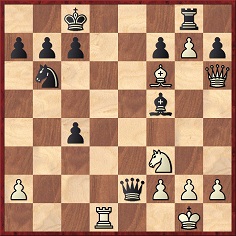
19 Re1 Qxa2 20 Qh5 Bg6 21 Qh3+ Kb8 22 Ne5 Qd2 23 Rf1 Qf4 24 Ng4 Bf5 25 f3 Nd7 26 Ba1 f6 27 Qh6 Qd6 28 Nxf6 Nxf6 29 Qxf6 Qxf6 30 Bxf6 b5 31 g4 Be6 32 Kf2 c6 33 Re1 Bd5 34 Re7 a5 35 Ke3 b4 36 Be5+ Ka8 37 Kd4 c3 38 Kc5 Resigns.
Source: La Prensa, 30 June 1911, page 15.
José Raúl Capablanca – Rolando Illa
Buenos Aires, 29 June 1911
Queen’s Pawn Opening
1 d4 d5 2 e3 Bf5 3 c4 e6 4 Qb3 b6 5 Nc3 Nf6 6 Nf3 Be7 7 Ne5 O-O 8 Bd2 c5 9 dxc5 bxc5 10 cxd5 exd5 11 Qb7 Nbd7 12 Nc6 Qe8
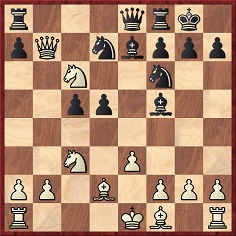
13 Qxa8 Qxa8 14 Nxe7+ Kh8 15 Nxf5 d4 16 exd4 g6 17 Ng3 cxd4 18 Nce2 Re8 19 O-O-O Qd5 20 Kb1 Rb8 21 Bc3 dxc3 22 Rxd5 Rxb2+ 23 Kc1 Resigns.
Source: La Nación, 30 June 1911, pages 9-10.
José Raúl Capablanca – Mariano Viaña
Buenos Aires, 20 September 1914
Four Knights’ Game
1 e4 e5 2 Nf3 Nc6 3 Nc3 Nf6 4 Bb5 Bb4 5 O-O O-O 6 d3 d6 7 Bg5 Bxc3 8 bxc3 h6 9 Bh4 Bg4 10 h3 Bxf3 11 Qxf3 g5 12 Bg3 Nd7
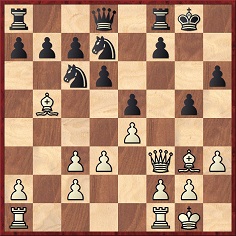
13 d4 Qe7 14 Rad1 Kg7 15 Qf5 Rad8 16 f3 Qf6 17 Qxf6+ Kxf6 18 Bf2 Kg6 19 Rb1 Nb6 20 h4 f6 21 g4 Rb8 22 Kg2 Kg7 23 Be3 Na5 24 Bd3 Nac4 25 Bc1 a5 26 Kf2 Rh8 27 Be3 Nxe3 28 Kxe3 Nd7 29 Bc4 Nf8 30 Bd5 b6 31 a3 Nd7 32 Be6 Rhd8 33 Bxd7 Rxd7 34 d5 c5 35 Kd3 Kf7 36 Kc4 Ke7 37 Kb5 Rc7 Drawn.
Source: La Nación, 21 September 1914, page 9.
José Raúl Capablanca – Mariano Viaña
Buenos Aires, 4 November 1914
Vienna Game
1 e4 e5 2 Nc3 Nf6 3 Bc4 Bc5 4 d3 d6 5 Bg5 Be6 6 Qf3 Nbd7 7 Nge2 h6 8 Bxf6 Nxf6 9 O-O O-O 10 Bxe6 fxe6 11 Qh3 Qe7 12 Kh1 Rf7

13 f4 exf4 14 Nxf4 e5 15 Ncd5 Nxd5 16 Nxd5 Qd7 17 Qxd7 Rxd7 18 Rf3 c6 19 Nc3 Rf8 20 Raf1 Rdf7 21 h3 g6 22 Nd1 Kg7 23 Rxf7+ Rxf7 24 Rxf7+ Kxf7 25 g3 d5 26 Kg2 Kf6 27 Kf3 a5 28 exd5 cxd5 29 Ne3 Bxe3 30 Kxe3 b6 31 c4 Ke6 32 b3 Kd6 33 a3 Kc6 34 b4 Kd6 35 Kd2 Kc6 36 Ke3 Kd6 Drawn.
Sources: La Nación, 5 November 1914, page 9 and La Prensa, 5 November 1914, page 11.
9554. Olga Menchik
From page 3 of the Hull Daily Mail, 13 January 1926:
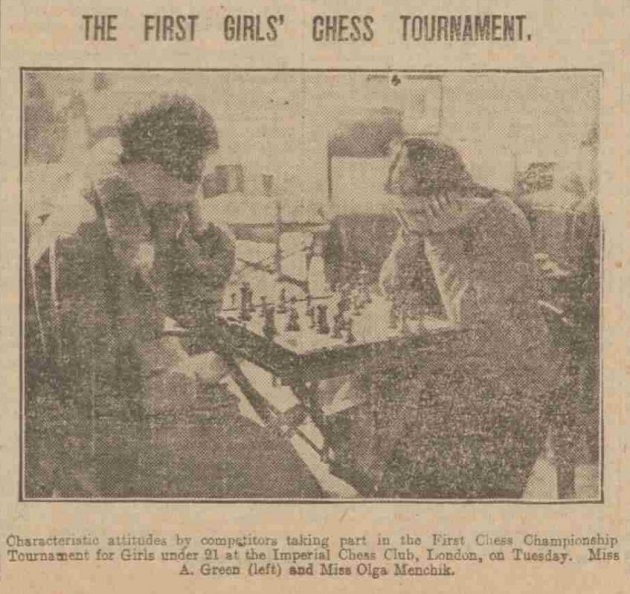
9555. Chess Personalia
If Gaige’s Chess Personalia (1987) were a federation’s project, a sub-committee might still be drafting the terms of reference.
9556. Buckle, not Bird (C.N. 9526)
When the picture of H.T. Buckle was published as the frontispiece to volume two of The Life and Writings of Henry Thomas Buckle by Alfred Henry Huth (London, 1880), the caption stated that he was aged 35:
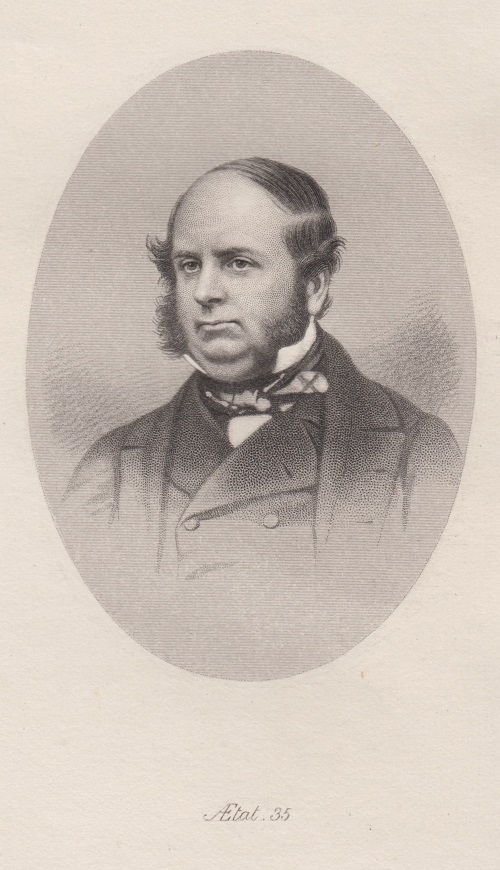
A similar picture appeared, with a chess theme, as the frontispiece to A Victorian Eminence by Giles St Aubyn (London, 1958):
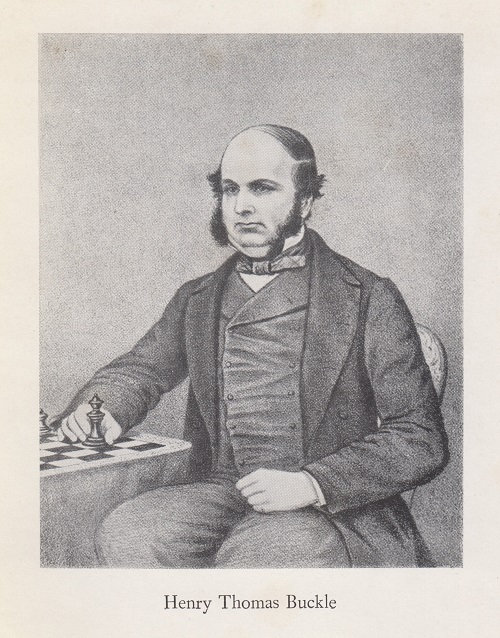
9557. Photographic archives (13)
Three photographs of Florencio Campomanes:
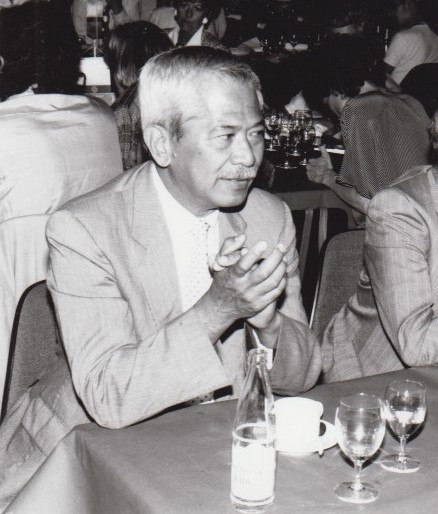
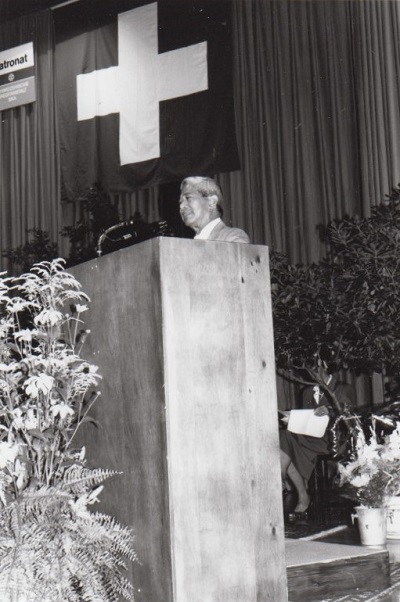
Biel, 1988
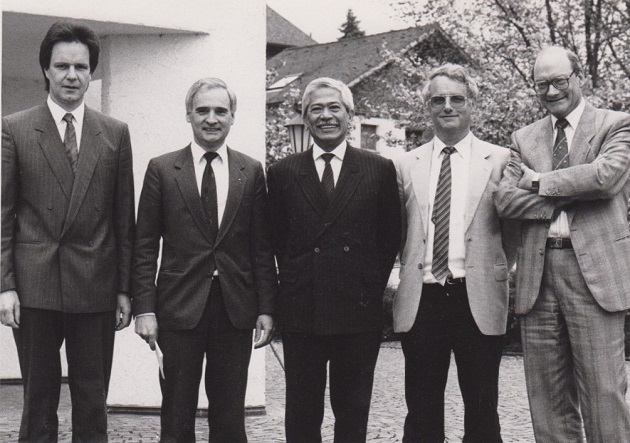
Internationale Schach-Open, Liechtenstein, 28 April 1989. From left to right: Georg Hassler, Harald Bühler, Florencio Campomanes, Ewald Marxer, Kurt Studer.
9558. Capablanca in Paris
Concerning Capablanca’s 40-board simultaneous display in Paris on 11-12 November 1911, below is the report on page 412 of La Stratégie, November 1911:
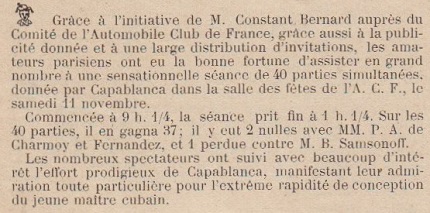
A photograph was published on page 12 of the 24 December 1911 issue of the Österreichische Illustrierte Zeitung:

9559. Hoit v Amateur
C.N. 1726 reported that we had jotted down this position from the 1984 film La Diagonale du Fou/Dangerous Moves:
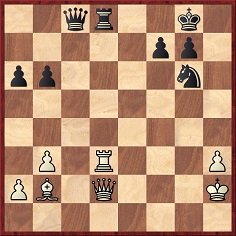
Black played 1...Qxh3+
The closing credits stated that Nicolas Giffard had created the games shown in the film.
In C.N. 1838 the late Jack O’Keefe pointed out that, with colours reversed, the position was almost identical to one published on page 134 of Chess Review, June 1938 (H.S. Hoit v Amateur, ‘a recent game’):

As mentioned on page 5 of Kings, Commoners and Knaves,
the Hoit ending was also on page 33 of
‘Chess can be brutal! Black’s king and queen are forced to move to the sixth rank, where a vicious knight lies in wait, poised for the kill.’
The first comment in The Fireside Book of Chess:
‘From a game Hoit-Amateur at New York, in 1938. The winning combination is so elegant that it gives the impression of being a composed ending. Only unique and felicitous chance can produce such exquisite possibilities in practical play.’
The conclusion was given too, without even Hoit’s name, on pages 133-134 of Reinfeld’s The Secret of Tactical Chess (New York, 1958), billed as ‘one of the most beautiful examples of double attack ever conceived on the chessboard’.
The starting-point in all three books was the position after 1 Qe3 Rxd6.
About Howard S. Hoit information is sought beyond what appeared on page 200 of the October 1942 Chess Review:

Above all, can the full score of Hoit’s brilliancy be found?
9560. Mate in six
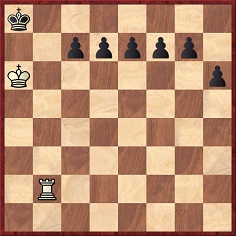
White to move.
9561. Magazines
On pages 36-37 of the 7/2015 New in Chess Nigel Short’s article about chess magazines includes this observation regarding the BCM:
‘Sadly, this once esteemed gazette has barely crawled into the 21st century, on life-support and with reputation threadbare, but, for much of its long existence, with its donnish prose, historical articles and news from distant dominions, it was a very fine read.’
Short also refers to the Australasian Chess Review
and Chess World, edited by Cecil Purdy:
‘The first World Correspondence Champion had such an admirable way of explaining games and expressing ideas with great clarity that it is no wonder that Bobby Fischer held him in high regard.’
Fischer’s opinion of Purdy as a teacher and annotator has often been mentioned, and we should like to cite any direct statements made by the American. In the meantime, an extract from the back cover of Purdy’s Guide to Good Chess (Davenport, 2006):

9562. Euwe and van Steenis (C.N. 9548)
Another game between the two players comes from page 4 of De Telegraaf, 3 January 1942:
Max Euwe – Hendrik Jan van Steenis
Beverwijk, January 1942
Caro-Kann Defence
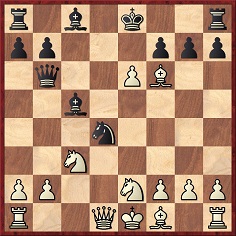
10...Nf3+ 11 gxf3 Bxf2+ 12 Kd2 gxf6 13 Qa4+ Kf8 14 e7+ Kg7 15 Qb5 Qe3+ 16 Kc2 Qxf3

17 Bg2 Bf5+ 18 Kb3 Be6+ 19 Ka3 Qe3 20 Rhg1 a6 21 Qh5 Qc5+ 22 Qxc5 Bxc5+ 23 b4 Bxg1 24 Rxg1 Kh6 25 Nd5 Bxd5 26 Bxd5 Rhe8 27 Nd4 Resigns.
9563. New York, 1889
If, as seems to be the case, no group photograph exists of the participants in the New York, 1889 tournament, is it known why?
9564. Whitman v Capablanca
From page 58 of the March 1927 American Chess Bulletin:

Patsy A. D’Eramo (North East, MD, USA) has found Capablanca’s game on page 4A of the Brooklyn Daily Eagle, 25 March 1927:
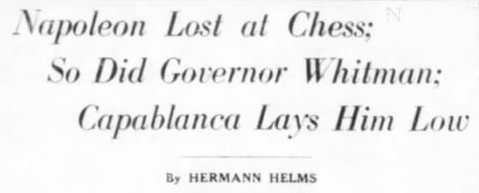
Charles Seymour Whitman – José Raúl Capablanca
New York, 25 March 1927
Dutch Defence
1 d4 f5 2 Nc3 Nf6 3 f3 d5 4 Nh3 c5 5 Nf4 cxd4 6 Qxd4 Nc6 7 Qa4 d4 8 Nb5 e5 9 Nd3 Bd7 10 Bg5 a6 11 Bxf6 gxf6 12 Qc4 axb5 13 Qxb5 Nb4 14 Qc4 Rc8 15 Qb3 Nxc2+ 16 Kf2 Nxa1 17 Qd1 Nc2 18 f4
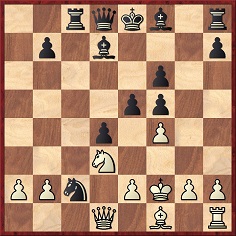
18...e4 19 Ne1 d3 20 exd3 Qb6+ 21 Kg3 Qe3+ 22 Kh4 Qxf4+ 23 Kh3 Qh6+ 24 Kg3 Bd6+ 25 Kf2 Qe3 mate.
9565. Verdoni
John Townsend (Wokingham, England) writes:
‘Is it known when Verdoni died, or where he was buried? Jacob Sarratt made a pertinent remark on page xxii of the first volume of his 1808 work A Treatise on the Game of Chess. Referring to the Traité des Amateurs, he commented:
“The principal players who assisted in compiling that treatise were Carlier, Leger, Bernard and Verdoni. The latter died at his apartments in Panton Street about four years ago; he was incontestably a player of the first order.”
This could be taken as indicating that Verdoni died about 1804, but it assumes that Sarratt wrote those words in 1808, the year his treatise was published. Is there any other evidence of Verdoni’s existence in England after, say, the year 1800?
Panton Street lay in the parish of St Martin in the Fields, Westminster. It is not far from Parsloe’s in St James’s Street, where Verdoni had moved the pieces for Philidor in a blindfold game on 20 June 1795. He was described in a newspaper report as “Mr Vardoni”; see page 37 of my 2014 book Historical notes on some chess players.
George Walker referred to him as “Signor Verdoni”, and it has been suggested that he was Italian by origin. The chess world knows so little about the life of this important player that his forename has not even been determined.’
Below is the entry on Verdoni on page 562 of the Dizionario Enciclopedico degli Scacchi by A. Chicco and G. Porreca (Milan, 1971):
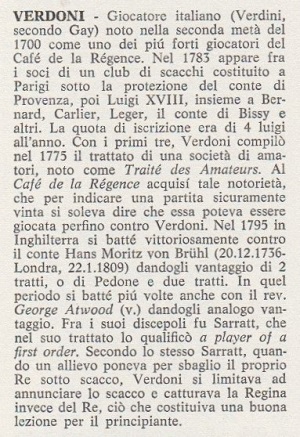
In reply to a correspondent, ‘L.D.’, the chess column by Löwenthal on page 14 of the Era, 23 November 1862 indicated that Verdoni was French:

9566. Alekhine in Montreal
C.N. 4985 gave this photograph from page 6 of the American Chess Bulletin, January 1924:
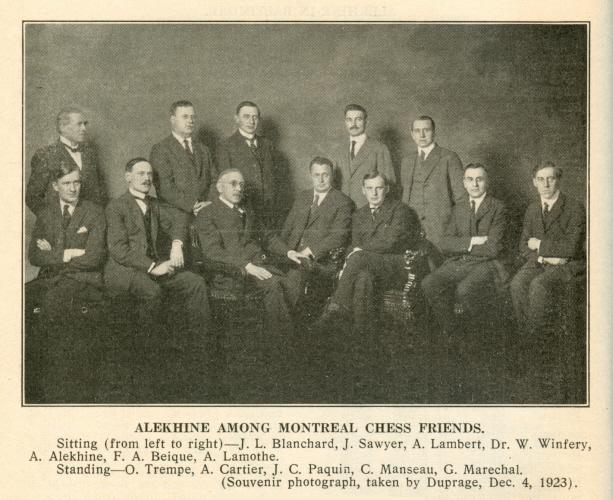
A better copy is online at the Library and Archives Canada website.
9567. Generalities
Three claims by Fred Reinfeld in The Joys of Chess (New York, 1961), on pages 185, 197 and 213 respectively:
- ‘In his old age Steinitz was such a fanatical preacher for defensive play that he must have regretted the brilliancies of his youth.’
- ‘All his life long, Rudolf Spielmann looked back nostalgically to the brilliant gambit chess of his grandfather’s day.’
- ‘Hypermodern chess. After World War I there sprang a school of chess thought that mirrored the postwar world of inflation, putsches and famine.’
9568. A book on Fischer in Icelandic
Aðalsteinn Thorarensen (Reykjavik) draws our attention to a new book in Icelandic, Yfir farinn veg með Bobby Fischer by Garðar Sverrisson:

9569. Tal on annotating
From page 25 of The Life and Games of Mikhail Tal by M. Tal (New York, 1976):
‘On the whole, I do not like annotating other people’s games. The point is that I consider that it is very difficult to penetrate into a player’s thinking, to guess the direction of the variations thought out by him, and therefore it is better to be indulgent towards one’s own games. I prefer to make my annotations “hot on the heels”, as it were, when the fortunes of battle, the worries, hopes and disappointments are still sufficiently fresh in my mind.’
On page 34 of the London, 1997 edition the wording was slightly different: ‘... it is better to direct one’s attention towards ...’
9570. Verdoni (C.N. 9565)
Jerry Spinrad (Nashville, TN, USA) points out that a death-date for Verdoni (25 January 1804, in London) was given in The Georgetown Chess Club Almanack for 1868 (Demerara, 1868) and that a footnote described him as ‘a player nearly equal to Philidor’:
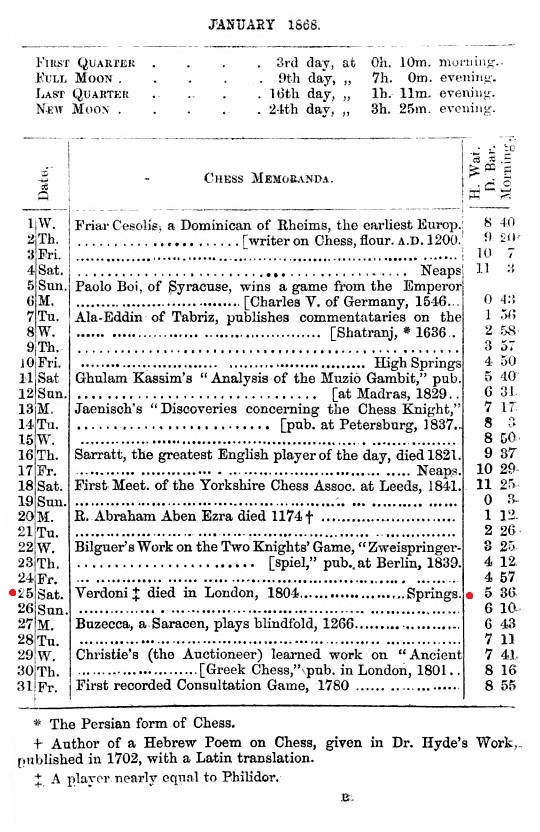
| First column | << previous | Archives [135] | next >> | Current column |
Copyright: Edward Winter. All rights reserved.
